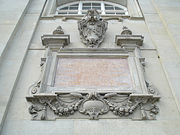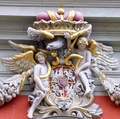Coat of arms of Lithuania
| Coat of arms of Lithuania Lietuvos herbas Vytis (Pogonia, Pahonia) | |
|---|---|
 | |
| Versions | |
 Presidential version | |
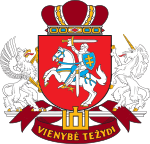 Parliamentary version | |
| Armiger | Grand Duchy of Lithuania, Republic of Lithuania |
| Adopted | First documented in 1366. Current version official since 1991. |
| Blazon | Gules, an armoured knight armed cap-à-pie mounted on a horse salient holding in his dexter hand a sword Argent above his head. A shield Azure hangs on the sinister shoulder charged with a double cross (Cross of Lorraine) Or. The horse saddles, straps, and belts Azure. The hilt of the sword and the fastening of the sheath, the stirrups, the curb bits of the bridle, the horseshoes, as well as the decoration of the harness, all Or. |
| Earlier version(s) | see below |
The coat of arms of Lithuania, consisting of an armour-clad knight on horseback holding a sword and shield, is also known as Vytis (pronounced ['vîːtɪs]).[1] It is recognized as the official coat of arms of Lithuania since the early 15th century and is also known in other Lithuanian language names as Waikymas, Pagaunė[2][3] or as Pogonia, Pogoń, Погоня (romanized: Pahonia) in the Polish, Belarusian and Ruthenian languages.[4][5][6][7][8][9] Vytis should be translated as Chase, Pursuer, Knight or Horseman, similar to the Slavic word Витязь (vityaz', Old East Slavic: brave, valiant warrior).[10] Historically – raitas senovės karžygys (mounted epic hero of old) or in heraldry – raitas valdovas (mounted sovereign).[10][11][12] The coat of arms of Lithuania is one of the oldest national coats of arms in Europe.[4][13][14]
The statehood of the powerful and vast Lithuanian state, first as the Duchy of Lithuania, then the Kingdom of Lithuania, and finally the Grand Duchy of Lithuania was created by the initially pagan Lithuanians, in reaction to pressures from the Teutonic Order and Livonian Brothers of the Sword which conquered modern-day Estonia and Latvia, forcibly converting them to Christianity.[15][16][17][18][19] Lithuania greatly expanded its territory by absorbing and occupying the present-day Belarusian, Ukrainian, and Russian territories, with the conquered regions retaining a large degree of autonomy under the Lithuanian rule.[20][21][18][22][23] The Lithuanians are the only branch of Baltic people that managed to create a state entity before the modern era.[24]
The horseback knight was first adopted by the ruling Gediminid dynasty as the dynasty's symbol, which depicted the Gediminids themselves, and in the early 15th century Grand Duke Vytautas the Great made the horseback knight on a red field as the coat of arms of the Grand Duchy of Lithuania, since then the coat of arms with Vytis (Pogonia) was used by the Lithuania's rulers and Lithuanian nobles related to the ruling dynasty.[6][4] The horseback knight's shield was designed to be decorated with the Columns of Gediminas or the Double Cross of the Jagiellonians.[25][26]
Article 15 of the Constitution of Lithuania, approved by national referendum in 1992, stipulates, "The Coat of Arms of the State shall be a white Vytis on a red field".[27] The heraldic shield features the field gules (red) with an armoured knight on a horse salient argent (silver). The knight is holding in his dexter hand a sword argent above his head. A shield azure hangs on the sinister shoulder of the knight with a double cross/two-barred cross Or (gold) on it. The horse saddle, straps, and belts are azure. The hilt of the sword and the fastening of the sheath, the stirrups, the curb bits of the bridle, the horseshoes, as well as the decoration of the harness, are or (gold).
The blazon is the following:
- Gules, a knight armed cap-à-pie mounted on a horse salient argent, brandishing a sword proper and maintaining a shield azure charged with a cross of Lorraine Or.
Origins of the word Vytis and other names
In early heraldry, a knight on horseback is usually depicted as ready to defend himself and is not yet called Vytis.[4] It is unknown for certain what Lithuania's coat of arms was initially called; Edmundas Rimša claims that the Ruthenian and Polish word Pogonia was first used for it in the 16th century.[28][29] The oldest record is in the Polish chronicler Marcin Bielski's Kronika wszystkiego świata (published in 1551, Kraków) in which he named the Lithuanian coat of arms as Pogonia, Pogoń for the first time and with the spread of the Polish language and culture, the term gradually became established.[4][6][30][7][9][31] Also, the term Pogonia is found in Prince Roman Sanguszko's documents from 1558 and 1564.[30]
Earlier the emblem was determined descriptively, for example, in a document of Supreme Duke Władysław of Varna from 1442, in Jan Długosz's Annales seu cronicae incliti Regni Poloniae or Bychowiec Chronicle from the beginning of the 16th century.[30][32] Another popular Polish term was pogończyk.[33] The symbol's meaning and appearance also changed: the old defender of the land became more and more like a rider chasing an enemy.[4] The name Pogonia was first recorded legally in the Third Statute of Lithuania of 1588.[34][35] The Lithuanian Statutes were still used due to well-made and advanced they were not only in Lithuania, but also in White Ruthenia and Little Russia following the Third Partition of Lithuania in 1795.[36]

The origins of the Lithuanian proper noun Vytis are also unclear. At the dawn of the Lithuanian National Revival, Simonas Daukantas employed the term vytis, referring not to the Lithuanian coat of arms, but to the knight for the first time in his historical piece Budą Senowęs Lietuwiû kalneniu ir Żemaitiû, published in 1846.[37][31] The etymology of this particular name is not universally accepted; it is either a direct translation of the Polish Pogoń, a common noun constructed from the Lithuanian verb vyti ("to chase"), or, less likely, a derivative from the East Slavic vityaz. In western South Slavic languages (Slovenian, Croatian/Serbian/Montenegrin and Macedonian) and Hungarian, vitez denotes the lowest feudal rank, a knight.[38] There also was a Hungarian Order of Vitéz, which was awarded as a State Order of Merit of Hungary from 1920 to 1944.[39] According to the Brockhaus and Efron Encyclopedic Dictionary, vitez is derived from the Old High German word Witing.[40]
The first presumption, raised by the linguist Pranas Skardžius in 1937, is challenged by some, as Pogoń does not mean "chasing (knight)".[41] In support of the second proposal, the Lithuanian language has words with the stem -vyt in such personal names as Vytenis; furthermore, vytis has a structure common to words constructed from verbs.[42] According to professor Leszek Bednarczuk, there existed a derivative word vỹtis, vỹčio in the Old Lithuanian language, which translates to English as pursuit (from persekiojimas), chase (from vijimasis).[41]
Already in the 13th century, the Old Prussian word vitingas meant an Old Prussian nobleman, knight.[43] In Lithuania, it is found in place names, personal names and by naming an action.[43] In the ancient times there could have been such a Lithuanian language word referring to reality – chasing an enemy or an armed horseman chasing an enemy.[43] It is also possible that Grand Duke Butvydas named his son Vytenis by knowing the Old Prussian language word vitingas (nobleman, military commander[44]).[3] Therefore, Grand Duke Vytenis' reign (1295-1316) is also associated with the word Vytis as the Ruthenian chronicle (so-called Hypatian Codex[45]) mentions that after beginning to rule the Grand Duchy of Lithuania in the 13th century, he came up with a seal with an armored horseman and a sword raised above his head (in the Codex's original Old Church Slavonic it is written that Vytenis named it Pogonia[3]).[46][47][48][49][14] Interpretations that his name can be associated with the coat of arms of Lithuania name in Lithuanian language – Vytis are strengthened by some historical sources in which places were named after him.[3] For example, Wythes Hof was used in the Teutonic Order's collection of historical sources called the Scriptores rerum Prussicarum (English: Authors of the Prussian history), which in German means Vytenis' Court, which was near the Lithuanian fortress of Bisenė as with its support Grand Duke Vytenis attacked the Teutonic fortress of Christmemel in 1315.[50][51][52][53][3] Another example is that Konstantinas Sirvydas, in 1629, wrote a toponym Vutec Kalnsь (English: Vytis'/Vyties' Mountain) on the basis of a document from , and associated it with personal names Vygailas, Vytenis, Vytautas.[5] This version is also supported by the fact that the Grand Dukes of Lithuania themselves were depicted on early Lithuanian seals,[4] therefore it is likely that the horseman on the Seal of Vytenis was named after him.[3]
The earliest known Lithuanian language name for the coat of arms of Lithuania Waikymas (Vaikymas in the modern Lithuanian orthography), mentioned by Konstantinas Sirvydas, is a 17th-century equivalent of Pogonia, which was used until the 19th century together with another Lithuanian name – Pagaunia.[54][4] Sirvydas also indicated its two meanings: waykitoias (English: pursuer) in the case of a person and waykimas (English: pursuing) in the case of an action.[33] The term waykimas is also mentioned in a Aegidius Kibler's German language book Geistliche Sendschreiben, Welche Das wahre, Christliche und vollkom[m]ne Leben, in allen Ständten der Menschen zu üben, in sich außführlich und klärlich begreiffen (published in 1700).[55]

In 1884, Mikalojus Akelaitis referred to the coat of arms of Lithuania per se as Vytis in the Auszra newspaper.[56][33] This name became popular and was eventually became official in the independent Republic of Lithuania. Originally called Vytimi in 1st person Sg. Dat., by the 1930s Vytis came to be called Vyčiu in 1st person Sg. Dat.[33]
The history between the Grand Duchy of Lithuania, the Lithuanian Jagiellonian dynasty and the Kingdom of Hungary and Kingdom of Croatia is closely related as Władysław III Jagiellon, the eldest son of Władysław II Jagiełło and his Lithuanian wife Sophia of Halshany,[57] was crowned as the King of Hungary and King of Croatia on 15 May 1440 in Visegrád, moreover, following his father's death, he also inherited the title of the Supreme Duke (Supremus Dux) of Grand Duchy of Lithuania, held it in 1434–1444 and presented himself with it, as such share of powers was agreed in the Union of Horodło of 1413 between his father and Grand Duke Vytautas the Great.[58][59][60] Furthermore, the Royal Seal of Władysław III Jagiellon includes a Lithuanian Vytis (Pogonia) with the wings of a hussar laid out above the coat of arms of Hungary and alongside the Polish Eagle.[61]
Lithuanian ethnologist and folklorist Jonas Trinkūnas suggested that the Lithuanian horseman depicts Perkūnas, who was considered as the god of the Lithuanian soldiers, thunder, lightning, storms, and rain in Lithuanian mythology.[47][62][63] Very early on, Perkūnas was imagined as a horseman and archeological findings testify that Lithuanians had amulets with horsemen already in the 10th–11th centuries, moreover, Lithuanians were previously buried with their horses who were sacrificed during pagan rituals, and prior to that it is likely that these horses carried the deceased to the burial sites.[47][62][64] Lithuanian mythologists believe that the bright rider on the white horse symbolizes the ghost of the ancestral warrior, reminiscent of core values and goals, giving strength and courage.[65]
Jonas Trinkūnas, the leader of neo-pagan movement Romuva, believes that in the Lithuanian mythology Vytis represents Perkūnas, a god of thunder.[47] It is believed that the Vytis may represent Perkūnas as supreme god or Kovas who was also a war god and has been depicted as a horseman since ancient times. Gintaras Beresnevičius also points out that a white horse had a sacral meaning to Balts.[66] These interpretations coincide with one of the interpretations of the German coat of arms, that suggests an adler being the bird of Odin, a god of war, which is commonly depicted as a horserider.
Grand Duchy of Lithuania
"We do not know on whose merits or guilt such a decision was made, or with what we have offended Your Lordship so much that Your Lordship has deservedly been directed against us, creating hardship for us everywhere. First of all, you made and announced a decision about the land of Samogitia, which is our inheritance and our homeland from the legal sucession of the ancestors and elders. We still own it, it is and has always been the same Lithuanian land, because there is one language and the same inhabitants. But since the land of Samogitia is located lower than the land of Lithuania, it is called as Samogitia, because in Lithuanian it is called lower land [ Žemaitija ]. And the Samogitians call Lithuania as Aukštaitija, that is, from the Samogitian point of view, a higher land. Also, the people of Samogitia have long called themselves as Lithuanians and never as Samogitians, and because of such identity (sic) we do not write about Samogitia in our letter, because everything is one: one country and the same inhabitants."
— Vytautas the Great, excerpt from his 11 March 1420 Latin letter sent to Sigismund, Holy Roman Emperor, in which he described the core of the Grand Duchy of Lithuania, composed from Žemaitija (lowlands) and Aukštaitija (highlands).[67][68] Term Aukštaitija is known since the 13th century.[69]
The old Lithuanian heraldry was characterized by the fact that the stamp symbols of the Lithuanian nobles consisted of various lines, arrows, framed in shields, colored and even passed down from generation to generation (they were mostly used until the Union of Horodło in 1413 when 47 Lithuanian families were granted the Polish coat of arms,[60] however, some Samogitian nobles began using the Polish heraldry only in mid-16th century[70]).[71]
13th century
Despite the conquests of the Balts who lived in the present-day Latvia and Estonia by the Teutonic Order and Livonian Brothers of the Sword, Lithuanians withstood foreign invasions and preserved their independence when in 1236 a chieftain Mindaugas united several tribes into a Lithuanian state and in 1251 accepted Roman Catholicism, thus was crowned by the papal legate as King of Lithuania in 1253, and so established the Kingdom of Lithuania.[17][24] According to the 1393 description, when the legend was still intact, the Seal of Mindaugas had an inscription: + MYNDOUWE DEI GRA REX LITOWIE (English: Mindaugas, by the grace of God, King of Lithuania), however authenticity of a partially survived seal, attached to an Act of 1255, according to which Selonia was transferred to the Livonian Order, is disputed.[72][73] The Western invaders pressure stimulated Lithuanians to expand their lands eastwards into Ruthenian Orthodox territory, and this expansive Lithuania was soon conveyed in the coat of arms of Lithuania which is a galloping horseman, a former woodland warrior who later perfected the Western armourers techniques.[23][20][21]

Following the assassination of King Mindaugas and his family members by Daumantas and Treniota in 1263, Lithuania lapsed into internal disorder as three of his successors Treniota, his son-in-law Švarnas, and his son Vaišvilkas were assassinated during the next seven years.[74] Stability did not return until Traidenis' reign, designated Grand Duke c. 1270.[74] The ancient Lithuanian capital Kernavė was first mentioned in 1279 in the Livonian Rhymed Chronicle by noting that the Livonian Order's army devastated an area in King Traidenis' lands, which was the main objective of this invasion (part of an early military clashes prior to the Lithuanian Crusade).[75] The coat of arms, seals or symbols of Traidenis are unknown.[76] However, archaeological findings in the 13th and 14th century necropolis in Kernavė offer an astounding variety of symbols and ornaments, of which plants, herbs, palmettes motifs, and suns (swastikas) are one of the most distinct symbols, depicted on the discovered headbands and rings, dating to the pagan period before the Christianization of Lithuania.[76]
14th century
Grand Duke Gediminas's authentic symbols did not survive, however it is known that in 1323 Gediminas sent 7 letters from his castle in Vilnius that also did not survive, therefore with them the Seal of Gediminas was also lost.[77] Nevertheless, the letter's content is known from a transcript as on 1 July 1323 notary (John of Bremen) in the city of Lübeck confirmed a transcript of 26 May 1323 letter of Gediminas and also in detail described the oval waxy seal which was attached to the letter.[78][77] According to the notary's transcript, the oval Seal of Gediminas had a twelve corners edging, at the middle of the edging was an image of a man with long hairs, who sat on a throne and held a crown (or a wreath) in his right hand and a sceptre in his left hand, moreover, a cross was engraved around the man along with a Latin inscription: S DEI GRACIA GEDEMINNI LETHWINOR ET RUTKENOR REG (English: Gediminas', by the grace of God, the King of the Lithuanians and the Rus' people, seal).[78][77][79] The usage of a cross in a pagan ruler's seal is explained as a diplomatic action because Gediminas did not accept baptism in his life and kept Lithuania pagan, despite several negotiations.[77][80][81] Also, Grand Duke Gediminas strictly distinguished Lithuania and Lithuanians from the region of Rus' (Ruthenia) and Rus' people (Ruthenians) in legal documents (e.g. in a 1338 Peace and Trade Agreement, concluded in Vilnius, between the Grand Duke Gediminas and his sons and the Master of the Livonian Order Everhard von Monheim).[82]

The most mysterious heraldic symbol of Lithuania is a spearhead with a cross, found on the early Lithuanian coins (also known as PEČAT or ПЕЧАТ coins) that were minted by Jogaila, Vytautas the Great, and possibly Algirdas or Skirgaila.[83][84] The mystery comes from the fact that it was used by both Jogaila and Vytautas, who fought the Lithuanian Civil War (1381–1384), therefore it is impossible that Jogaila used his rival's symbol, however it is also not a dynastic symbol like the Columns of Gediminas.[83] A particularly important argument for determining the time of minting the PEČAT-type coins is the treasure discovered in Borshchiv (near Kyiv) in which a PEČAT-type coin was found along with the hryvnia of the Novgorod Republic, coins of the Grand Prince of Kyiv Vladimir Olgerdovich, and dirhams of the Golden Horde's Khans (the latest coins of them are of Khan Tokhtamysh, minted in the early 1380s).[83] Vladimir Olgerdovich, son and vassal knyaz of Algirdas, minted coins at the Principality of Kiev since the 1360s, therefore it is highly unlikely that his father Algirdas did not mint his own coins at the late period of his reign.[85][84] Furthermore, the Lithuanians were skilled at fighting using spears, especially on horseback, and the earliest written mention of such tactics dates to 1208 when Lithuanians, riding on horses, threw spears into their enemies.[86][87]

As a result, the PEČAT-type coins can be attributed to the reign of Grand Duke Algirdas as well and the usage of a cross on a pagan ruler's coins can be seen as a yet another diplomatic action of the Gediminids (like in his father's Gediminas' seal) because despite being a talented diplomat, Algirdas was not baptized in his life and was pagan as he tortured and executed Anthony, John, and Eustathius (Russian Orthodox Muscovite missionaries) in Vilnius in 1347 for their religion, despite his marriages with Orthodox Princesses Maria of Vitebsk in 1318 and Uliana of Tver in 1349.[77][88][89][90] Nevertheless, the spearhead with a cross symbol on the anonymous coins could have been created to showcase Algirdas marriages with the Orthodox princesses, especially with Uliana of Tver, who was known for her involvement in the politics (e.g. following Algirdas' death in 1377, she advised their son Jogaila to sign the Treaty of Dovydiškės in 1380, which resulted in the murdering of Algirdas's brother Grand Duke Kęstutis,[91] who for his wholesome support previously was a coruler of Lithuania with Algirdas and also a staunch pagan,[92][93] in 1382).[85] Moreover, Algirdas unified all modern-day Belarusian and most of the Ukrainian lands under the Lithuanian state and he earned Ukrainian loyalty for respecting Ukrainian culture and the Ukrainian Church.[94] The alleged Seal of Algirdas with arrows and name Olger was proved to be a falsification by , who modified the 1388 Seal of David of Gorodets (David Dmitrovich), husband of Jogaila's sister Maria, which was published by , notwithstanding Algirdas in fact had a similar ducal seal, but the original was not preserved in a visual form.[83][95] After becoming the ruler of Lithuania, Algirdas was titled as the King of Lithuania (Latin: rex Letwinorum) in the Livonian Chronicles instead of the Ruthenian terms knyaz (English: prince, duke) or velikiy knyaz (grand prince).[96][97]


The Columns of Gediminas are one of the earliest surviving national symbols of Lithuania and its historical coats of arms.[98] It was suggested by historian Edmundas Rimša, who analyzed the ancient coins, that the Columns of Gediminas symbolize the Gates of the Trakai Peninsula Castle.[99] There is no data that they were used by Grand Duke Gediminas himself, and it is believed that their name originated when Gediminas was considered the founder of the Gediminids dynasty.[98] Since 1397, the Columns of the Gediminids were undoubtedly used on the coat of arms of Grand Duke Vytautas the Great, and it is believed that a similar symbol may have been used by his father Kęstutis, who was Duke of Trakai and Grand Duke of Lithuania, titles which Vytautas inherited.[25][98][100] After Vytautas' death, the symbol was taken over by his brother Grand Duke Sigismund Kęstutaitis.[25] At first, the Columns used to represent the family of Kęstutis, and since the 16th century, when Grand Duke Jogaila's successors started using them in Lithuania as well, the Columns became the symbol of all Gediminids.[25] It was Grand Duke Alexander Jagiellon who made the Columns of the Gediminids as the coat of arms of his dynasty after becoming the Grand Duke of Lithuania in 1440.[98] In heraldry, the Columns of Gediminas were usually pictured in gold or yellow on a red field, while they were occasionally portrayed in silver or white since the second half of the 16th century.[25] There is no doubt that the Columns of the Gediminids are of local origin as similar symbols can be found on the insignias of the Lithuanian nobility.[25] It is believed that the Columns of the Gediminids were derived from signs used to mark property.[25]
Compared to the Double Cross of the Jagiellonian dynasty, the Columns of the Gediminids had been used more predominantly in the Grand Duchy of Lithuania.[25] The Columns of the Gediminids were featured on the Lithuanian coins of the 14th and subsequent centuries; the banners of the regiments led by Grand Duke Vytautas at the Battle of Grunwald; the 15th and 16th century church paraphernalia given to Vilnius Cathedral; the 15th century seals of the Lithuanian Franciscans and major state seals in 1581–1795; book graphics; and the pieces of work by Vilnius' goldsmiths.[25][101][102] Combined with knight on horseback, the Columns of Gediminas were also embedded on the Lithuanian cannon barrels in the 16th and 17th centuries.[25] The symbol also decorated horse bridles and landmarks of the dominions of the Grand Dukes of Lithuania.[25] Following the death of Grand Duke Sigismund II Augustus, the last male descendant of the Gediminids, in 1572, the Columns of the Gediminids remained in the insignias of the Grand Duchy of Lithuania as the secondary (alongside the knight on horseback) coat of arms of the state.[98] In later years, the Columns of Gediminas were called simply as the Columns (it is known from the early 16th century sources).[98]
In 1337, a Lithuanian banner is mentioned for the first time in Wigand of Marburg's chronicles, who wrote that during the battle at Bayernburg Castle (near Veliuona, Lithuania) Tilman Zumpach, head of the Teutonic riflemen, burned the Lithuanian banner with a flaming lance and then mortally wounded the King of Trakai, however he did not describe the appearance of the banner of the King of Trakai.[103]
The knight on horseback without a specific name was mentioned in the Chronicles of Lithuania and Samogitia (so-called Tobolsk Chronicle), found in the Archives of Tobolsk, as a symbol of Duke Narimantas:
"...that Narimantas had in his seal a coat of arms, some kind of Horseman, which was made as a sign of the Grand Duchy of Lithuania. It depicted a brave man on a white horse on a red bottom, with a naked sword, as if he was chasing something...".[104][14]
The coat of arms of Lithuania is one of the few coats of arms that originate from seals portraying images of dukes rather than dynastic coats of arms.[33][4] Lithuanian Grand Duke Algirdas may have been the first duke to have used a seal with an image of himself on horseback, however his seal, attached to the Treaty with Kingdom of Poland of 1366, has not been preserved.[33][65] Nevertheless, historian Tadeusz Czacki claimed to have seen such a Seal of Algirdas attached to the 1366 Treaty.[14][46] Grand Duke Jogaila's brother Vygantas, at the time the Duke of Kernavė, was the first one in Lithuania to have used a shield painted with a riding knight in 1388, thus giving the knight image a status of a coat of arms.[33]

Jogaila, who became the Grand Duke of Lithuania following the death of his father Grand Duke Algirdas in 1377, and Jogaila's brothers: Skirgaila, Lengvenis, Kaributas, Vygantas, and Švitrigaila each had several seals with horseman-type images.[6][33] The horseman was chosen due to at the time flourishing culture of knighthood in Europe.[65] At first, the charging knight was depicted riding to left or right, and holding a lance instead of the sword: two seals of Lengvenis of 1385 and of 1388 exhibit this change.[105] The establishment of the sword in the heraldry of the Lithuanian rulers is related to the ideological changes of the ruling Gediminids dynasty.[105] The lance was more often exhibited on the seals of Skirgaila and Kaributas.[4] In 1386, after Jogaila was crowned as King of Poland, a new heraldic seal was made for him, with quarterly first eagle, representing Kingdom of Poland, and quarterly second knight on a horse, with lance in hand and a Double Cross on his shield, representing the Grand Duchy of Lithuania.[33] The Double Cross was adopted by Jogaila after his baptism as Ladislaus and marriage with a Hungarian princess and Queen of Poland Hedvig Angevin in 1386, therefore the Double Cross was taken over from the Kingdom of Hungary where it spread in the 12th century from the Byzantine Empire.[106] The symbolism of the Double Cross was connected with this event's significance for both Jogaila and the entire land.[26] A similar cross in Western heraldry is called the patriarchal Cross of Lorraine, and it is used by archbishops while the cross itself symbolizes baptism.[26]


15th century
The meaning of the Lithuanian ruler coat of arms and the coat of arms of the Lithuanian state was given to the horseman not by Jogaila, but by his cousin, the Grand Duke Vytautas the Great.[4] Firstly, around 1382, he changed the infantry on his coat of arms, inherited from his father Grand Duke Kęstutis, to a horseman, then made the portrait heraldic – in Vytautas' majestic seal (early 15th century), he is surrounded by coat of arms of lands belonging to him, in one hand he holds a sword, which represents the power of the Grand Duke of Lithuania, in the other hand – a raised shield (on which a horseman is depicted), which, like an apple of royal power, symbolizes the Lithuanian state ruled by him.[4][65] In the 15th century, Jan Długosz claimed that Vytautas brought forty regiments to the victorious Battle of Grunwald in 1410 and that everyone used red flags of which thirty regiments flags had an embroidered armored horseman with a raised sword riding on a white, sometimes black, bay or dappled horse, while the rest of ten regiments flags had embroidered Columns of Gediminas with which Vytautas marked his elite troops with horses.[103][101][102] According to Długosz, those flags were named after lands or dukes: Vilnius, Kaunas, Trakai, Medininkai, Sigismund Korybut, Lengvenis, and other.[103] It is believed that the regiments with the Columns of Gediminas were brought from Vytautas' homeland (the Duchy of Trakai), and with a horseman – from other areas of the Grand Duchy of Lithuania.[103]
Sigismund Korybut during his visit to Prague at the invitation of the Czech Hussites in 1422 as a delegate of Grand Duke Vytautas the Great, was depicted in a drawing wherein he carries his armorial banner decorated with a white charging knight on a red field; at its top, there is a narrow streamer, which the Germans, in particular, were fond of depicting in the 15th century.[103]


Several very rare Lithuanian coins were found with a lion or leopards and the Columns of Gediminas, dated to the reign of Vytautas the Great and Jogaila in the 14th century (one of them was found in Kernavė).[107] There is still disagreement where these coins were minted, with the most likely locations being Smolensk (most likely), Polotsk, Vyazma, Bryansk, and Ryazan.[107][108] Such coins symbolized vassal relationships of the Ruthenian lands.[108] The leopards were depicted with lily-shaped tails, which symbolizes a sovereign ruler, therefore such Vytautas' coins must have been minted after the Pact of Vilnius and Radom in 1401 when Vytautas became fully in charge of the Lithuanian affairs.[107][109] Vytautas minted such coins with leopards in the Principality of Smolensk before its Uprising of 1401 and after 1404 when it became a permanent part of Lithuania.[107] Another type of Lithuanian coins with lion and node symbol are found in Eastern Lithuania and Vilnius, which by researchers are associated with Skirgaila or Jogaila, however such associations lack genuine evidence as the Seal of Jogaila attached to the Union of Krewo and the 1382 Seal of Skirgaila were not preserved.[110] Despite that, it is possible that the Ruthenian lion also was one of the early coat of arms of the Grand Duchy of Lithuania as Jogaila in the Union of Krewo entitled himself as: Nos Jagalo virtute Dei dux magnus Litwanorum Rusieque dominus et heres naturalis (English: With God's will of the Grand Duke of Lithuania and the natural lord and heir of Rus).[110] It was suggested by historian that lion was abolished as the coat of arms of Lithuania after the Union of Krewo because in medieval heraldry it was equivalent to the Polish Eagle (lion is the king of animals, while eagle is the king of birds) and Lithuania at the time became a vassal state of the Kingdom of Poland, thus had a lower status.[111][112][113] Although, it is important to note that the Lithuanian dukes and nobles declined Uliana of Tver's, Jogaila's mother, suggestion to baptise the Lithuanians as Orthodox before the Union of Krewo and sought Catholicism instead.[114] Grand Duke Jogaila also rejected the Grand Prince of Moscow Dmitry Donskoy's offer to marry his daughter Sofia, convert Lithuania into an Orthodox state and to recognize himself as a vassal of Dmitry Donskoy, instead he chose Catholicism and married Queen Jadwiga of Poland, but also continued titling himself as a ruler of all the Rus' people, therefore minted coins with a portrait of himself (as a horseman) on the obverse and a lion with a braid above him on the reverse, other Jogaila's coins features the Polish Eagle instead of his portrait on one side and a lion on the other side.[115] In 2021, a treasure was discovered in Raišiai, Vilnius district with 40 Jogaila's coins (Denars), some of which are with lions while others are with horsemen wielding swords or spears, most of these coins were minted in 1377–1386 (prior to crowning of Jogaila as the Polish King).[116][117]
Following the Christianization of Lithuania, in ~1388, Grand Duke Jogaila minted new coins: with a fish rolled into a ring (Christian sign of the fish) and inscription КНЯЗЬ ЮГА (English: Duke Jogaila) on the obverse and with a Double Cross of the Jagiellonians in a shield on the reverse.[115] It is believed that such coins were minted to commemorate the Christianization of Lithuania and the Christian sign of the fish could have been chosen when Pope Urban VI officially recognized Lithuania as a Catholic state (such recognition occurred on 17 April 1388).[115] Nevertheless, a fish–blossom symbol, depicted on the coins, can also be associated with an earlier date of 11 March 1388 when Pope Urban VI recognized the Roman Catholic Diocese of Vilnius, which was established by Grand Duke Jogaila.[115] In any case, the main purpose of this symbol was to showcase the Grand Duchy of Lithuania as a Catholic state, recognized and under the auspices of the Pope.[115] Lithuania was the last state in Europe to be Christianized.[118]


At the end of the 14th century, the knight on horseback appeared on the first Lithuanian coins, however, this figure had not yet fully formed, therefore in some coins, the knight is depicted as riding to the left, in others – to the right.[13] In some he holds a spear while others depict a sword; the horse can either be standing in place or galloping.[13] The Double Cross was used in isolation on the Lithuanian coins of the late 14th century and on the banner of the royal court referred to in Lithuanian language as Gončia (English: The Chaser).[26] During the reign of Grand Duke Alexander Jagiellon, who ruled Lithuania from 1492 to 1506, the depiction of the direction of the knight was established – the horse was always galloping to the left (in the heraldic sense – to the right).[13] Also, the knight was for the first time depicted with a scabbard, while the horse – with a horse harness, however, the knight does not yet have on his shoulder a shield with the double-cross of the Jagiellonian dynasty.[13] Moreover, Alexander's coins also depict an eagle as the symbol of the Grand Dukes of Lithuania's dynastic claim to the Polish throne.[13] During the reign of Grand Duke Sigismund I the Old, who ruled Lithuania from 1506 to 1544, the image of the horseman was moved to the other side of the coins – the reverse, thus marking that it was the coin of Grand Duchy of Lithuania.[13] The knight was also for the first time depicted with a shield with the Double-Cross of the Jagiellonian dynasty.[13] In heraldry, such an image of the horseman is only associated with the Lithuanian state.[13] In the 15th century, the Double Cross of the Jagiellonians became an integral part of the Lithuanian coat of arms and was started to be depicted on the horseman's shield.[119]
At the beginning of the 15th century, the colors and composition of the seal became uniform: on a red field a white (silver) charging knight with a sword raised above his head, with a blue shield with a Double Golden Cross to his left shoulder (during the reign of Kęstutaičiai dynasty – red shield with the golden Columns of Gediminas); horse bridles, leather belts and a short girdle – colored in blue.[4][33][120] Metals (gold and silver) and the two most important colors of medieval coats of arms were used for the Lithuanian coat of arms – Gules (red) then meant material, or earthly (life, courage, blood), Azure (blue) – spiritual, or heavenly (heaven, divine wisdom, mind) values.[4][33]
16th century

Only in the 16th century a distinction between the ruler (Grand Duke) and state emerged (it was the same entity previously), from which time one also finds mention of a state flag.[103] In 1578, Alexander Guagnini was the first to describe such a state flag, according to him the state flag of the Grand Duchy of Lithuania was made of red silk and had four tails, its principal side, to the right of the flag staff, was charged with a white mounted knight underneath the ducal crown; the other side bore an image of the Blessed Virgin Mary.[103] The highly revered Blessed Virgin Mary was considered the patron saint of the state of Lithuania, and even the most prominent state dignitaries favoured her image on their flags, thus the saying: "Lithuania – land of Mary".[103] Later only the knight is mentioned embroidered on both sides of the state flag.[103]
After the Union of Lublin, which was signed on 1 July 1569 in Lublin, Poland, the Polish-Lithuanian Commonwealth was established, thus a joint coat of arms of the new country was adopted.[33] Its four quarterly fields portrayed, in diagonal, the eagle and the riding knight as the symbols of the two constituent states.[33] Hence, the old colors of the coat of arms of Lithuania, probably influenced by the colors of the coat of arms of Poland (red, white, and yellow), began to change: sometimes the horse blanket was depicted in red or purple, the leather belts in yellow; however the horseman's shield with the golden Double Cross changed less.[4] In 1572, following the death of Grand Duke Sigismund II Augustus, the last male descendant of the Jagiellonian dynasty as he did not leave any male heir to the throne, the Double Cross remained as a symbol in the national coat of arms and was started to be referred to as simply the Cross of Vytis (Waikymas) after losing the connection with the dynasty.[26]
17th century to 1795
The Renaissance introduced minor stylistic changes and variations: long feathers waving from the tip of the knight's helm, a long saddle-cloth, the horsetail turned upwards and shaped as nosegay. With these changes, the red flag with its white knight survived until the end of the 18th century and Grand Duke Stanislaus II Augustus was the last Grand Duke of Lithuania to employ it.[103] His flag was colored in crimson, had two tails, and was decorated with the knight on one side and the ruler's monogram – SAR (Stanislaus Augustus Rex) on the other side.[103] SAR monogram was also inscribed on the flagpole finial.[103] In 1795, after the Third Partition of the Polish-Lithuanian Commonwealth, Grand Duchy of Lithuania was annexed to the Russian Empire and traditional coat of arms of Lithuania, which represented the state for more than four centuries, was abolished and the Russification of Lithuania was imposed.[4]
- Coat of arms of the Grand Duchy of Lithuania
One of the oldest colorful Vytis (Waikymas) depiction, 14th century

One of the earliest surviving depictions of Vytis (Waikymas) from the Bavarian State Library, 1475[121]

Duke Sigismund Korybut and his troops flying a Lithuanian Vytis (Waikymas) in Prague, 15th century

The first page of the Latin copy of Laurentius (1531) of the First Statute of Lithuania. Vytis (Waikymas) is drawn on a damasked shield.

Tapestry with the coat of arms of Grand Duke Sigismund II Augustus

Coat of arms of the Polish–Lithuanian Commonwealth during the reign of the Vasa dynasty

Authentic Vytis (Waikymas) depicted on the Gate of Dawn, which survived annexations
Authentic Vytis (Waikymas) depicted on the outer wall of the Chapel of Saint Casimir

Grand Duke Stephen Báthory's tomb monument in the Wawel Cathedral with Vytis (Waikymas)
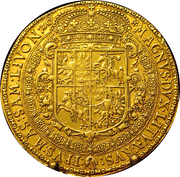
A coin of 15 ducats of Grand Duke Sigismund III Vasa from 1617

The Great Seal of Lithuania with Vytis (Waikymas) and Columns of Gediminas, belonging to Władysław IV Vasa
The Grand Seal of the 1st Cavalry Brigade of the Grand Duchy of Lithuania Husarska (18th century)

Coat of arms of the Polish–Lithuanian Commonwealth, used during the reign of Stanislaw August Poniatowski, 1764–1795
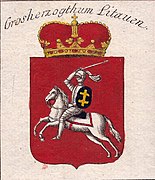
Lithuanian coat of arms with the Double Cross of the Jagiellonian dynasty, depicted by Franz Johann Joseph von Reilly in 1793
Russian and German empires

However, in 1845 tsar Nicholas I confirmed a coat of arms for the Vilna Governorate that closely resembled the historical one.[4] A notable later change was the replacement of the Double-Cross of the Jagiellonians with the red Byzantine cross on the knight's shield.[4]
At first, the charging knight was interpreted as the ruler of the country. As time passed, he became a knight who is chasing intruders out of his native country. Such an interpretation was especially popular in the 19th century, and the first half of the 20th century, when Lithuania was part of the Russian Empire and sought its independence.[4] A notable example of the coat of arms of Lithuania usage during the Tsarist period is on the bridge railings above the Vilnelė River in Vilnius.[122]
Following the partition of the Polish–Lithuanian Commonwealth, most of the Grand Duchy of Lithuania was absorbed by the Russian Empire and Vytis was incorporated into the Greater Coat of arms of the Russian Empire.[122] Vytis was the coat of arms of the Vilna Governorate following the incorporation of Vilnius and surrounding lands into the Russian Empire.[123][124][125] Statues of Vytis placed on the White Columns of Vilnius greeted visitors at the entrances to Vilnius from 1818 until 1840, when the statues were replaced with the double-headed eagles – the state symbol of the Russian Empire.[126] In 2019, it was suggested by the Mayor of Vilnius Remigijus Šimašius that the White Columns of Vilnius in the city's eldership of Naujamiestis should be restored.[126]

Uprisings to restore the Polish–Lithuanian Commonwealth like the 1830–31 November Uprising and 1863–64 January Uprising saw Vytis (Waikymas) being used as a symbol of rebellion against the Russian Empire.[127][128][129] The Lithuanian Vytis was widely used alongside the Polish White Eagle throughout the uprisings on flags, banners, coins, banknotes, seals, medals, etc.[8] After the dethronement of Emperor Nicholas I Romanov (Emperor of Russia since 1825, King of Poland 1825–1831) by the Sejm during its proceedings in Warsaw on 25 January 1831, the coats of arms of the Russian Emperors were removed from the mint dies and Polish złotys with Eagle and Vytis were introduced into circulation, which were manufactured at the Warsaw's Banknote Factory and minted at the Warsaw Mint, as on 9 December 1830 the Provisional Government appointed the Bank of Poland to manage the Warsaw Mint.[130] The 1863–64 January Uprising spread especially wide in the ethnic Lithuanian lands, whereat many rebels demanded for a completely independent, sovereign Lithuanian state, however at the time the majority of the Lithuanians decided to support the Polish–Lithuanian union in order to fight the Russian oppression more effectively.[131] In the Soviet times, the 1863–64 January Uprising was interpreted as a class struggle between peasantry and landed aristocracy, while since 1990, it came to be seen in Lithuania as a strife for liberation from the Russian rule.[132]
On 22 November 2019, upon the rediscovery of their remains on the Gediminas' Hill, the 1863–64 January Uprising commanders Konstanty Kalinowski and Zigmantas Sierakauskas were buried at the Rasos Cemetery in Vilnius, while the flags covering their coffins were presented to the President of Lithuania Gitanas Nausėda and the President of Poland Andrzej Duda.[133]
Several authentic coat of arms of Lithuania survived the occupations and annexations. For example, on the side wall of the Vilnius Cathedral, on the main portal of the Dominican Church of the Holy Spirit and on the Gate of Dawn.[122][134]
During the Lithuanian National Revival in the 19th century, the Lithuanian intellectuals such as Teodor Narbutt and Simonas Daukantas claimed that the reviving Lithuanian nation is the inheritor of the Grand Duchy of Lithuania heritage, including the Lithuanian coat of arms Vytis (Waikymas), which was widely used in their organized events.[135]
In 1905, the Great Seimas of Vilnius took place in Vilnius during which the decision to demand wide political autonomy of Lithuania within the Russian Empire was made.[136] It was proposed by the Chairman of the Great Seimas of Vilnius Jonas Basanavičius to recognize the flag of the Grand Duchy of Lithuania (a white horse rider on a red bottom) as the flag of Lithuania, but this proposal was rejected due to the negative associations of red color with the 1905 Russian Revolution.[103][137]
The discussions on the national flag resumed during the World War I. Following the German Empire occupation of Lithuania in September 1915, the Lithuanians gathered into committees and organizations of various currents, which united their representatives.[137] According to the signatory of the Act of Independence of Lithuania of 16 February 1918 Petras Klimas, they considered the main problems of the reestablishment of Lithuania's statehood, among which one of the main questions were the national colors and the national flag.[137] Although, serious discussions about the Lithuanian state flag and coat of arms resumed only in 1917 when the real prospect of restoring the Lithuanian state emerged.[137]

For the first time, according to Petras Klimas, a specific question of the national flag and national colors was raised at the Lithuanian intelligentsia Consortium Meeting of 6 June 1917 in the premises of the Lithuanian Scientific Society (the so-called Consortium Meeting united Lithuanian intellectuals in Vilnius, such as: Jonas Basanavičius, , Petras Klimas, Jurgis Šaulys, Antanas Smetona, Mykolas Biržiška, , Steponas Kairys, Aleksandras Stulginskis, Antanas Žmuidzinavičius).[137] During this Consortium Meeting, Jonas Basanavičius read a report in which he proved that in the past the color of the Lithuanian flag was red and that on the red bottom was depicted a rider with a raised sword on a dapple-grey horse.[137] Jonas Basanavičius suggested continuing this tradition and choosing this option as the flag of the reborn Lithuanian state.[137] There was nobody who opposed it, however considerations began that such variant of the national flag does not solve the issue of the national colors, especially because a red flag without Vytis (Pogonia) could not be used.[137]
As a result, new colors had to be chosen that could form a simple, everyday, easily sewn flag, which would be used alongside the historical flag of Vytis (Waikymas)).[137] The members of this meeting established the principle according to which national colors had to be chosen: everyone agreed that it is necessary to choose such colors that are most often found in folk wares, ribbons, aprons, etc.[137] Everyone agreed that such colors are green and red, therefore the task of harmonizing these colors in the flag was assigned to the artist Antanas Žmuidzinavičius, however the searching for a color combination took a long time.[137] Artist and archeologist Tadas Daugirdas', who was invited as a consultant, combinations of the national flag colors varied from those proposed by Antanas Žmuidzinavičius.[137] In general, a question of the number of colors arose as some demanded a green-red flag (such proposal was also supported by the Lithuanian Americans), while the others demanded a tricolor combination.[137] Finding the third color was the most difficult task, even an exhibition of flag projects was held, however, the question was not solved until the Vilnius Conference of 1917, therefore a question of the national colors was included into the agenda of the Vilnius Conference.[137]

During the preparation of the Vilnius Conference, which met in Vilnius and set out the guidelines for the restoration of Lithuania's independence and elected the members of the Council of Lithuania, Antanas Žmuidzinavičius prepared a green-red Lithuanian flag project with whom the Vilnius City Theater Hall (present-day Russian Drama Theatre of Lithuania) was decorated.[137] However, the flag proposed by Antanas Žmuidzinavičius seemed gloomy to the Vilnius Conference participants.[137] Consequently, Tadas Daugirdas proposed the flag consisting of green at the top, white in the middle and red at the bottom, but he himself was not fond of such proposal as he preferred the green and red combination because these colors dominated in the Lithuanian cloths.[137] Finally, Tadas Daugirdas proposed to include a narrow yellow line between the other two colors of green and red with the yellow color symbolizing dawn (the first national Lithuanian newspaper was also named Aušra) and rebirth (Lithuanian National Revival).[137] Despite that, Antanas Žmuidzinavičius categorically defended the green and red flag as these colors symbolized love and hope, while the others demanded for a green (at the bottom; symbolizing green fields and meadows), yellow (at the middle; symbolizing yellow blossoms), and red (at the top; symbolizing the rising sun).[137] As a result, the participants of the conference did not decide on the colors of the flag, therefore assigned this question to a commission formed by the Council of Lithuania that consisted of Jonas Basanavičius, Antanas Žmuidzinavičius, and Tadas Daugirdas.[137]
On 16 February 1918, the Council of Lithuania declared the Independence of Lithuania and adopted Vytis as its coat of arms with the first drafts of the coat of arms being designed by Tadas Daugirdas and Antanas Žmuidzinavičius.[33][138] On 19 April 1918, the commission accepted a Lithuanian flag project which consisted of three equal width horizontal lines of yellow, green, and red colors.[137] On 25 April 1918, the Council of Lithuania unanimously approved this flag project as the Flag of the State of Lithuania.[137] At the meeting of the same day, it was proposed to raise the tricolor flag of the Lithuanian state above the Tower of the Gediminas' Castle, which was done in the middle of 1918 after difficult negotiations with the German authorities.[137]
Following the occupation of Vilnius by Soviet Russia, the Lithuanian institutions were evacuated to the temporary capital Kaunas in the first days of January 1919. In the temporary capital Kaunas, the historical flag of Lithuania was raised above the Presidential Palace, Palace of Seimas, and on top of the Tower of the Vytautas the Great War Museum (this historical flag was previously adopted by the Council of Lithuania and had a white horseman on a red bottom on one side and the Columns of Gediminas on the other side).[137][138]
- Coat of arms of the Russian Empire Governorates in the former Grand Duchy of Lithuania and other illustrations from the period

The White Columns of Vilnius (1818-1840) with Vytis (Pogonia), which were later replaced with the double-headed eagles

Seal of the Duma of the City of Vilnius, 19th century
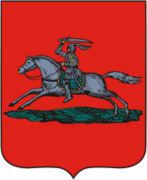
Coat of arms of Vilna Governorate (1845)

Seals of the Vilnius University, middle of the 19th century

Hat of a soldier of the 17th Lithuanian Uhlan Regiment of the Grande Armée with the Lithuanian coat of arms
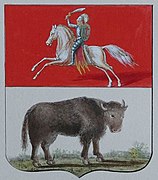
Coat of arms of Grodno Governorate, 1802
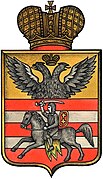
Coat of arms of Vitebsk from 1781

Coat of arms of Vitebsk Governorate (1856)
Painting commemorating Polish–Lithuanian union; ca. 1861. The motto reads "Eternal union".

Relics of the Uprising of 1831, exhibited in the National Museum of Lithuania in Vilnius

Coat of arms of the November Uprising, 1830–31
Banner with emblem of the November Uprising, 1830–31

Emblem of the January Uprising, 1863–64

Vilnius Conference in 1917 with flags of Vytis
Republic of Lithuania in the interwar period
"What is the ideal of our nation? It is inscribed on the symbol of our state, inherited from the ancient times. Other nations have lions, Ares, or other symbols of power in their flags. It is beautiful, it is majestic! We have Vytis, an armored horseman on a horse with a sword in his hand, rushing with gallops. It is beautiful, it is noble! He, as published in the ancient writings, was chanted by the Vaidilas [ a clergymen in the Baltic religion ], sung by the singers. That symbol is the pride of our nation: a symbol of chivalrous justice. Let us never forget him, either in our relations with our minorities or with other states. Until we are faithful to him, no one will defeat us. The knight is righteous, but he is equipped with armors and has a sword in his hand. When necessary, he pulls out the sword and stands up for justice against those who despise it. To depict justice in this way is to feel and act not only statesmanlike, but also nationally."
— Antanas Smetona, the first and last President of interbellum Lithuania (1919–1920, 1926–1940) about the coat of arms of Lithuania.[139][140]

When Lithuania restored its independence in 1918–1920, several artists produced updated versions of the coat of arms. Almost all included a scabbard, which is not found in its earliest historical versions. A romanticized version by Antanas Žemaitis became the most popular.[4] The horse appeared to be flying through the air (courant). The gear was very ornate. For example, the saddle blanket was very long and divided into three parts.[4] There was no uniform or official version of the coat of arms. To address popular complaints, in 1929 a special commission was set up to analyze the best 16th-century specimens of Vytis to design an official state emblem.[33] Mstislav Dobuzhinsky was the chief artist.[33] The commission worked for 5 years, but its version was never officially confirmed.[33] Meanwhile, a design by Juozas Zikaras was introduced for official use on Lithuanian coins.[4]
The Columns of the Gediminids and the Double Cross of the Jagiellonians were particularly widely used in the first half of the 20th century following the restoration of the independent state of Lithuania on 16 February 1918.[25][26] These symbols, as a distinctive sign, were adopted by the Lithuanian Land Forces, Lithuanian Air Force, and other public authorities.[25][26] It was used to decorate Lithuanian coins, banknotes orders, medals, and insignias and became an attribute of numerous public societies and organizations.[25][26] To commemorate the 500th anniversary of the death of Grand Duke Vytautas the Great, flags decorated with the Columns of the Gediminids were hoisted in Lithuanian cities and towns in 1930.[141] Moreover, in his honor, a Lithuanian state award was instituted in the same year – Order of Vytautas the Great, which was awarded for distinguished services to the State of Lithuania and since 1991 is still conferred nowadays.[142]
In 1919, the Double Cross of the Jagiellonians was named the Cross for Homeland and was featured on one of the highest-ranking Lithuanian state decorations – Order of the Cross of Vytis, which was awarded for acts of bravery performed in defending the freedom and independence of Lithuania (the order was abolished following the occupations of Lithuania, but was re-established in 1991).[26][143] According to a presidential decree of 3 February 1920, issued by the President of Lithuania Antanas Smetona, the Cross for Homeland was renamed to the Cross of Vytis.[26] In 1928, the Order of the Lithuanian Grand Duke Gediminas was instituted and was awarded to the citizens of Lithuania for outstanding performance in civil and public offices (it was also abolished following the occupations of Lithuania, but was re-established in 1991).[144]
Vytis was the state emblem of the Republic of Lithuania until 1940 when the Republic was occupied by the Soviet Union and national symbols were suppressed, those who still displayed them received severe punishments.[25] With the dissolution of the Soviet Union, the Vytis, together with the Columns of Gediminas and the national flag, became symbols of the independence movement in Lithuania.[25][145] In 1988, Lithuania's Soviet authorities legalized the public display of Vytis (Waikymas).[146]
- Coat of arms of the Republic of Lithuania in the interwar
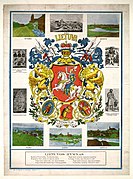
An unknown version of the First Lithuanian Republic coat-of-arms, probably its greater coat of arms

A design of Vytis by Antanas Žmuidzinavičius; popular in interwar independent Lithuania

Juozas Zikaras' design (1925), widely used on the interwar independent Lithuania coins
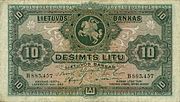
A banknote of 10 Lithuanian litas with Vytis and the Columns of the Gediminids (1927)
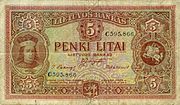
A banknote of 5 Lithuanian litas with Vytautas the Great and Vytis, 1929
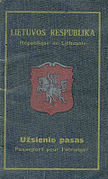
A foreign passport of the Republic of Lithuania with Vytis, used until the 1940 annexation
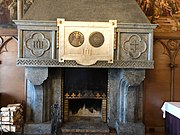
A fireplace of a sitting-room of Vytautas the Great at the Kaunas Garrison Officers' Club Building

Queen Louise Bridge, which at the time connected the Lithuanian town Panemunė and Prussian city Tilsit, decorated with Vytis in 1937

Ministry of Finance of Lithuania Building in Kaunas, decorated with portraits of Antanas Smetona, Vytautas the Great, Vytis and the Columns of Gediminas, 1930

Commander of the Lithuanian Army Stasys Raštikis holds the Lithuanian Army flag with Vytis, while a Lithuanian soldier swears his loyalty by kneeling in front of it

A Lithuanian bomber-reconnaissance monoplane ANBO VIII with the Double Cross of the Jagiellonians, constructed by the Lithuanian aeronautical engineer Antanas Gustaitis, in 1939

Lithuanian Vickers Light Tanks M1936 with the Columns of the Gediminids, heading to the Lithuanian capital Vilnius in 1939

Session of the Provisional Government of Lithuania, which attempted to restore the statehood of the interwar Republic during the June Uprising in Lithuania, in 1941

The Lithuanian partisans fought with the occupants in 1944–1953, wearing the interwar Lithuanian uniforms and symbols
Republic of Lithuania in the post-Cold War era

On March 11, 1990 Lithuania declared its independence and restored all of its pre-war national symbols, including its historic coat of arms Vytis.[33] On March 20, 1990, the Supreme Council of Lithuania approved the description of the State's coat of arms and determined the principal regulations for its use.[33] The design was based on Juozas Zikaras' version.[33] This was to demonstrate that Lithuania was resuming the traditions of the state that existed between 1918–1940. On September 4, 1991, a new design by Arvydas Každailis was approved based on the recommendations of a special Lithuanian Heraldry Commission.[33] It abandoned romantic interwar interpretations, harkening back to the times of the Grand Duchy of Lithuania. Nevertheless, it re-established the original colors and metals (red, blue, silver, and gold), dating to the reign of Grand Duke Vytautas the Great, but placed the horse and rider in an ostensibly more "defensive" posture, airs above the ground, rather than leaping forward and sword simply elevated rather than poised to strike.[4][33] The revival of historical colors and the historical coat of arms Vytis meant that the Republic of Lithuania is not only the heir and follower of the traditions of statehood of independent Lithuania of 1918–40, but also of the Grand Duchy of Lithuania.[4] The Constitution of the Republic of Lithuania, adopted by citizens of the Republic of Lithuania in the Constitutional Referendum of 25 October 1992, states that the Coat of Arms of the State shall be a white Vytis on a red field.[27] Despite the newly adopted Každailis' variant of Vytis, the Lithuanian litas coins featured Zikaras' design until they were replaced by the euro in 2015.[147][148]
On 10 April 1990, the Supreme Council – Reconstituent Seimas adopted the Law on the National Coat of Arms, Emblems, and Other Insignias of the Republic of Lithuania, which regulates the usage of the Lithuanian national coat of arms Vytis and the historical national symbols of Lithuania.[149] According to the 6th article of this Law, the historical national symbols of Lithuania are the Double Cross of the Jagiellonians and Columns of Gediminas.[149]
In 2004, Lithuania's Seimas confirmed a new variant of the Vytis on the historical flag of Lithuania.[103] It is depicted on a rectangular red fabric, recalling the old battle flags of the Grand Duchy of Lithuania.[103] The flag does not replace the yellow-green-red tri-color national flag of Lithuania and it is used on special occasions, anniversaries, and buildings of historical significance (e.g. Palace of the Grand Dukes of Lithuania, Trakai Island Castle, Medininkai Castle).[103]
It is currently proposed that a larger version of the coat of arms be adopted. It would feature a line from "Tautiška giesmė", the national anthem of Lithuania, "Vienybė težydi" (English: "May unity blossom"). The Seimas already uses a larger version of the coat of arms with this phrase as its motto, along with two supporters: the dexter one a griffin argent beaked and membered or, langued gules, and the sinister one a unicorn argent, armed and unguled or, langued gules, and the ducal hat on top of the shield. The President of Lithuania uses the shield and supporters only.
Lithuania joined the Eurozone by adopting the euro on 1 January 2015.[150] The designs of Lithuanian euro coins share a similar national side for all denominations, featuring the Vytis and the country's name in Lithuanian – Lietuva.[148] The design was announced on 11 November 2004 following a public opinion poll conducted by the Bank of Lithuania.[151] The horse is again leaping forward, as in more traditional versions.[148]
Gintautas Genys released a three-tomes historical adventure novel book Pagaunės medžioklė (English: The Hunt for Pagaunė), which analyzes different periods of the history of Lithuania: the first tome, released in 2012, is about the last decade of the 18th century (close to the Third Partition of the Polish-Lithuanian Commonwealth),[152] the second tome, released in 2014, presents the vision of the restoration of the Grand Duchy of Lithuania in the sticky web of intrigues and conflicts of the monarchs of France, Russia, and Prussia,[153] while the third tome, released in 2019, presents the course of the history of Russia, Poland, and Lithuania from the 1810s to 1860s, consistently and vividly reveals the terrible drama of mutual relations between them.[154]
- Coat of arms of the Republic of Lithuania in the Post-Cold War era

An Anti-Soviet rally in Vingis Park of about 250,000 people in 1988. The Columns of the Gediminids are hanging above the stage.

The presidential version of the coat of arms, as depicted on the Presidential Palace, and the Flag of the President of Lithuania
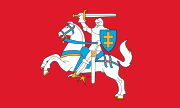
The historical state flag of Lithuania with Vytis

Modern Lithuanian flag featuring Vytis

The current passport of the Republic of Lithuania design
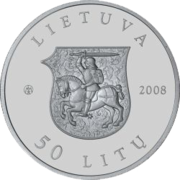
Litas commemorative coin featuring a historical Vytis

A banknote of 500 Lithuanian litas with Vytis, 2000
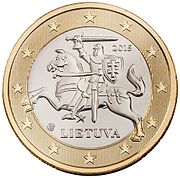
A coin of 1 Lithuanian Euro with Vytis, used since 1 January 2015

The Lithuanian soldiers with the Columns of Gediminas during the Battle of Grunwald reconstruction

Flag of the Lithuanian Armed Forces with the Columns of the Gediminids

An armoured fighting vehicle Vilkas (Lithuanian variant of Boxer) with the Columns of the Gediminids

Lithuanian Air Forces aircraft with the Double Cross of the Jagiellonians in 2016
Jotvingis (N42) of the Lithuanian Naval Force with the historical state flag of Lithuania
Similar coats of arms
Lithuania
Recently adopted coats of arms of Vilnius and Panevėžys counties use different color schemes and add additional details to the basic image of the knight.[155] Several towns in Lithuania use motifs similar to Vytis. For example, the coat of arms of Liudvinavas is parted per pale. One half depicts the Vytis and the other, Lady Justice.[156]
- Coats of arms of the Lithuanian counties, cities, and towns which features a horseman

Ethnographic region Aukštaitija coat of arms
Vilnius University coat of arms

Vilnius County coat of arms

Liudvinavas coat of arms
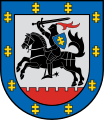
Panevėžys County coat of arms
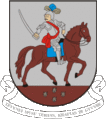
Veiviržėnai coat of arms
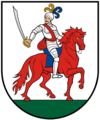
Josvainiai coat of arms
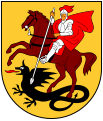
Marijampolė coat of arms

Daugailiai coat of arms
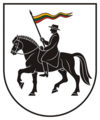
Adutiškis coat of arms
Poland
As Lithuania and Poland were closely related for centuries, especially during the Polish-Lithuanian Commonwealth period, the Lithuanian coat of arms was also depicted in Poland.[8]
- Usage of Vytis (Pogonia) in Poland

Vytis (Pogonia) is depicted on one of the Wawel Castle's towers in Kraków, alongside the Polish Eagle and the Double Cross of the Jagiellonians
John III Sobieski's coat of arms crowning the Royal Chapel in Gdańsk with Vytis (Pogonia)

Vytis (Pogonia) as depicted on the façade of the Collegium Novum of the Jagiellonian University in Kraków

Illustration with coat of arms of John I Albert (after 1492)

Illustration with coat of arms of Stanislaw August Poniatowski, 1780

Białystok Voivodeship (1919–1939) and Podlaskie Voivodeship (1513–1795) coat of arms

Brańsk coat of arms
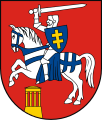
Puławy coat of arms

Siedlce coat of arms
Church of the Nativity of the Blessed Virgin Mary in Piaseczno

Malbork Castle, Malbork, 1590s
Wawel, Kraków
Wawel, Kraków
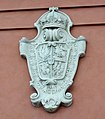
Royal Castle, Warsaw, 17th century

Royal Castle, Warsaw, Warsaw, 18th century

Post milestone, Lubań, 1725
Royal Castle, Warsaw, Warsaw, 18th century

Łazienki Park, Warsaw, 18th century

Guardhouse, Poznań, 1780s
Belarus

Based on the data of archeology, ethnography, anthropology, and linguistics, professor Leszek Bednarczuk makes an assumption that the Belarusian ethnos and language were formed due to the dependence on the Grand Duchy of Lithuania,[158][5] and during this epoch of Lithuanian domination, the Belarusian language and nationality began to take shape.[20] Despite the fact that the Belarusians share a distinct ethnic identity and language, they never previously had a political sovereignty prior to 1991, except during a brief period in 1918.[159]
Unique Belarusian national symbols only appeared in the 20th century, as Belarusians created their first state entity in 1918 and adopted a plain white flag, which referred to their name as White Ruthenians.[157] Subsequently, this flag was modified by adding a red horizontal stripe to it, and these colors of a white–red–white flag were derived from the Lithuanian coat of arms, which was used in Belarus during Lithuanian rule.[157]
Interwar
On 25 March 1918, a small group of Belarusian nationalists declared the formation of a Belarusian People's Republic.[160] Although, less than a year later, the Soviets claimed the same territory for a Byelorussian Soviet Socialist Republic.[160] In 1921, the Peace of Riga was signed, which officially divided the Belarusian lands between Poland (Western Belorussia) and the Soviet Union (Eastern Belorussia).[160] The Polish government engaged in a Polonization policy in Western Belorussia, therefore a sporadic partisan warfare against Polish authorities occurred until the mid-1920s, which was also supported by Lithuania,[160] because it fought the Polish–Lithuanian War (part of the Lithuanian Wars of Independence).[161]
In the Lithuanian Army

A Belarusian unit named Pirmasis baltgudžių pėstininkų pulkas (English: 1st Belarusian Regiment), commanded by Alaksandar Ružancoŭ (Lithuanian: Aleksandras Ružancovas), was formed mainly from the residents of Grodno in 1919 within the Lithuanian Armed Forces, which also participated in supporting the Independence of Lithuania during the Lithuanian Wars of Independence, therefore many members of this unit were awarded with the highest state award of Lithuania – Order of the Cross of Vytis.[162][163] Moreover, a Lithuanian Ministry for Belarusian Affairs (Lithuanian: Gudų reikalų ministerija) was established within the Government of Lithuania, which functioned in 1918–1924, and was led by the ethnic Belarusian ministers such as Jazep Varonka, Dominik Semashko.[162] The ethnic Belarusians were also included into the Council of Lithuania,[164] and the Belarusian political leaders initially requested for a political autonomy of the Belarusian lands with the Belarusian language as the official language in them within the restored Lithuania before losing all control over the Belarusian territories to the Poles and Soviets.[165] According to the Lithuanian President Antanas Smetona, following a successful recapture of the Lithuanian capital Vilnius, which was previously annexed by Poland, the Lithuanians planned to expand further into the Belarusian territories (the former lands of the Grand Duchy of Lithuania) and considered granting an autonomy to the Belarusian territories, as requested by the Belarusian side, therefore had kept the Lithuanian Ministry for Belarusian Affairs in force, moreover, in 1924 Smetona noted that there were a lot of pro-Lithuanian sympathies among the Belarusians.[166][167]

The Belarusian unit of the Lithuanian Armed Forces in Grodno was disbanded by the Poles following the annexation of it by the Polish Armed Forces, while the soldiers of this unit were disarmed, looted, and publicly humiliated by the Polish soldiers, who even ripped off the Belarusian officers insignias from their uniforms and trampled these symbols with their feet in public, as documented in the historical documents sent by the Belarusians to the temporary Lithuanian capital Kaunas because this unit refused to carry out the Polish orders and stayed loyal to Lithuania.[168][169] Following the annexation of Grodno, the Lithuanian yellow–green–red, Belarusian white–red–white flags, and signs with the Lithuanian coat of arms were torn off and the Polish gendarmes dragged them on the dusty streets for ridicule; instead of them, the Polish signs and flags were raised in their place everywhere in the city.[168][170] Soldiers and Catholic officers of the Belarusian regiment in Grodno were offered to join the Polish Army, while those who refused were offered to leave or were arrested, put into the concentration camps or deported from the native land by the Poles, part of the Belarusian soldiers and officers of this regiment evacuated to Kaunas and continued serving for Lithuania.[168][171][172]
After the collapse of USSR
The white–red–white flag and Vytis were yet again adopted upon proclaiming of Belarus' independence in 1991.[173] Soon after the 1994 Belarusian presidential election, in a 1995 referendum, the Belarusians voted for the introduction of a modified version of the Soviet flag, the introduction of Russian as the second official language, and the government's course on close economic integration with Russia (see: Union State).[174][175] The referendum was held because many Belarusians had expressed their dissatisfaction with the newly adopted symbolism of Belarus.[176] During the referendum 75.1% of Belarusians agreed to change the state symbols and according to Mikhail Pastukhov, the former judge of the Constitutional Court of Belarus, there are no grounds to treat the referendum as invalid as there were no serious violations in the course of the vote, however he also noted that the results of the referendum on giving the Russian language the equal status with the Belarusian language are invalid from the legal point of view and should be abolished.[177] According to Galina Miazhevich, such decision was made as the Belarusians were “one of the most wholehearted bearers of Soviet identity”,[178] because before communism Belarus was one of the poorest countries in Europe with the lack of statehood and delayed national movement.[174][175] Following the referendum, President Alexander Lukashenko cheerfully announced that "we have returned to you the flag of the country for which you fought. We have returned to you both memory and sense of human pride".[179] However, the previous symbols continued to be used by the Belarusian opposition and gained exceptional popularity among the Belarusians during the 2020–2021 Belarusian protests.[180] The white–red–white flag is banned by the Belarusian authorities.[181]
The Belarusian variant of the Lithuanian coat of arms Vytis (Pogonia) is very similar but differs slightly. In particular, the patriarchal cross with arms of uneven length is displayed on the shield, the saddle blanket is of the Renaissance style, the horse's tail points down instead of up, and Azure is absent from it altogether.[182]
- Usage of Vytis (Pahonia) in Belarus

The Vytis (Pahonia) as used in the Belarusian People's Republic in 1918

Passport of the Belarusian People's Republic, 1918–1919

Lithuanian Ministry for Belarusian Affairs (Lithuanian: Gudų reikalų ministerija), which existed between 1918 and 1924 in Lithuania

Seal of the Lithuanian Army's Belarusian Battalion, 1919

Alaksandar Uśpienski, commander of the 1st Belarusian Regiment in Grodno (1919), also of the Belarusian Battalion of the Lithuanian Armed Forces (1920–1921)

Alaksandar Ružancoŭ, commander of the Belarusian units within the Lithuanian Armed Forces (1919–1920), with the Lithuanian uniform, state awards

Testimony for awarding a Lithuanian Army Volunteer Founders Medal to Belarusian Vitalius Kozlov from Vitebsk, 1928
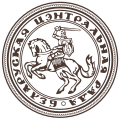
Seal of the Byelorussian Central Council in 1943–1944 (during the period of the Nazi occupation)

Coat of arms of Belarus from 1991 to 1995

Belarusian opposition supporters holding flags with Vytis (Pahonia) during the 2020–2021 Belarusian protests
Ukraine
The horseman was featured on the coat of arms of the Kingdom of Galicia–Volhynia, on the Seal of King Yuri II Boleslav with the Ruthenian lion on the coat of arms, on the Mykhailo Hrushevsky's proposal of the coat of arms of the Ukrainian People's Republic, and other Ukrainian coats of arms.
- Coats of arms in Ukraine which features a horseman

Coat of arms of the Kingdom of Galicia–Volhynia, 1313

Seal of King Yuri II Boleslav denoting a horseman with lion on the coat of arms (14th century)

King Yuri II Boleslav's coin of the Kingdom of Galicia–Volhynia (14th century)

Iziaslav coat of arms with the Double Cross of the Jagiellonian dynasty

Watch tower of Vytautas the Great in Kherson with the historical state flag of Lithuania
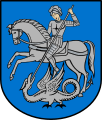
Variation of Pogon Ruska for the city of Kamianets-Podilskyi in 1374–1796 until occupation of Podolia by Russian Empire
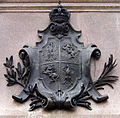
Adam Mickiewicz Monument, Lviv, 1904

Mykhailo Hrushevskyi's proposal for the coat of arms of the Ukrainian People's Republic

Oleksii Rudenko's, Artem Shchyhol's, Yaroslav Pavlysynsia's and Oleh Odnorozhenko's 2020 proposal of the Great Coat of Arms of Ukraine

Oleh Odnorozhenko's and Artem Shchyhol's 2020 proposal of the Great Coat of Arms of Ukraine
Noble families
| Pogoń Litewska | |
|---|---|
| Alternative name(s) | Pogoń Litewska Książęca |
| Families | show 57 names |
| Cities | Puławy |
| Divisions | Puławy County |
The Lithuanian coat of arms with some modifications was adopted by several Gediminid Lithuanian, Polish and Russian noble families, namely Czartoryski,[183] Sanguszko,[184] Chowanski,[185] Trubetskoy[186] and Golitsyn.[187] In Polish heraldry, those coat of arms are called Pogoń Litewska.[188]
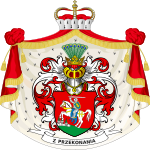
Sanguszko coat of arms
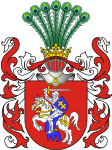
Simple version

Beyzym, a variation
Other locations
Austria
- Vytis in Austria

Albertina, Vienna, 18th century

Coat of arms on the Cenotaph of Maria Christina in Vienna
France
- Vytis in France
Catholic church, Nancy, 18th century
Pediment of the Nancy Town Hall

Vytis on top of Palais de la Cité's Tour de l'Horloge clock, Paris, since 1585
Germany
- Vytis in Germany
Freiberg Cathedral in Freiberg, Saxony, 18th century

Coat of arms on the Moritzburg Castle in Moritzburg, Saxony

Zwinger, Dresden, 18th century

Dresden Cathedral, Dresden, 18th century

Coat of arms on the Palace Übigau with Hercules, Dresden
Coat of arms on a cannon in Königstein Fortress, Dresden

A postal milestone in Löbau, Saxony state

Bridge over Mulde, Grimma, 18th century

Town hall, Wilsdruff, 18th century

Coats of arms on the Theatine Church in Munich, 18th century

Coat of arms on the Walderdorff Palace in Trier, 18th century

A Saxon milepost in Lengenfeld, Saxony state

A postal milestone, dated 1731, in Bad Gottleuba, Saxony state

A postal milestone in Grimma, Saxony state

A postal milestone in Niemegk, Brandenburg state

A postal milestone in Elsterwerda, Brandenburg state

A postal milestone in Senftenberg, Brandenburg

Portal of a post office in Wurzen, Leipzig district, 1734

Coat of arms of Lithuania from the Johann Siebmacher's book Siebmachers Wappenbuch
See also
| Wikimedia Commons has media related to National coats of arms of Lithuania. |
- Emblem of the Lithuanian Soviet Socialist Republic
- Flag of Lithuania
References
- ^ "Lietuvių kalbos žodynas". www.lkz.lt. Retrieved 2020-05-18.
- ^ "Kultūros uostas Paroda "Vytis istorijoje ir dailėje"". kulturosuostas.lt (in Lithuanian). 17 December 2019. Retrieved 10 April 2021.
- ^ Jump up to: a b c d e f Galkus, Juozas (26 May 2020). "Apie Vyčio pradžią ir vardą". alkas.lt (in Lithuanian). Retrieved 21 March 2021.
- ^ Jump up to: a b c d e f g h i j k l m n o p q r s t u v w x Rimša, Edmundas. "Lietuvos valstybės herbas". Vle.lt (in Lithuanian). Retrieved 19 March 2021.
- ^ Jump up to: a b c Palionis, Jonas (2012). "Acta Linguistica Lithuanica" (PDF) (in Lithuanian) (LXVI). Lithuanian Language Institute: 174. Retrieved 21 March 2021. Cite journal requires
|journal=(help) - ^ Jump up to: a b c d Petrauskas, Rimvydas. "Vytis, the Sign of the Dynasty | Orbis Lituaniae". LDKistorija.lt. Vilnius University. Retrieved 1 May 2021.
- ^ Jump up to: a b Bielski, Marcin (1551). Kronika wszystkiego świata (in Polish). Kraków: Jagiellonian Library. Retrieved 23 April 2021.
- ^ Jump up to: a b c Skoczek, Tadeusz (2016). Together with the White Eagle through the Ages: A Symbol of Rulers, the State, and the Nation (in English and Polish). Warsaw: Muzeum Niepodległości w Warszawie (Museum of Independence). pp. 66–73, 88–99. ISBN 978-83-62235-79-7. Retrieved 10 April 2021.
- ^ Jump up to: a b Bielski, Marcin (1597). Kronika Polska M. Bielskiego. Nowo przez I. Bielskiego syná iego wydána [and continued 1576-86] (in Polish). w Drukární J. Sibeneychera. pp. 6–7. Retrieved 22 April 2021.
- ^ Jump up to: a b "Vytis reikšmė - lietuvių kalbos žodynas". lietuviuzodynas.lt (in Lithuanian). Retrieved 9 April 2021.
- ^ "Vytis, vyčio, vyties; kryžius". vlkk.lt (in Lithuanian). Commission of the Lithuanian Language. Retrieved 9 April 2021.
- ^ Butkus, Alvydas. "Kas yra Vytis (atsakymas Bogdanui)". DELFI (in Lithuanian). Retrieved 9 April 2021.
- ^ Jump up to: a b c d e f g h i "Vytis (Knight) on the Lithuanian Money". Pinigumuziejus.lt. Bank of Lithuania Money Museum. Retrieved 19 March 2021.
- ^ Jump up to: a b c d Galkus, Juozas (2009). Lietuvos Vytis / The Vytis of Lithuania (in Lithuanian and English). Vilnius Academy of Arts Press. p. 13. ISBN 978-9955-854-44-9.
- ^ "Balt | people". Encyclopedia Britannica. Retrieved 11 April 2021.
- ^ Biezais, Haralds. "Baltic religion". Encyclopedia Britannica. Retrieved 11 April 2021.
- ^ Jump up to: a b "Baltic states - Prehistory to the 18th century". Encyclopedia Britannica. Retrieved 29 April 2021.
- ^ Jump up to: a b "Grand Duchy of Lithuania". Encyclopedia Britannica. Retrieved 8 May 2021.
- ^ "Lithuania - Historical Development". Eurydice Network. European Commission. 2 January 2019. Retrieved 11 April 2021.
- ^ Jump up to: a b c "Belarus: Lithuanian and Polish rule". Encyclopedia Britannica. Retrieved 29 April 2021.
- ^ Jump up to: a b "Ukraine: Lithuanian and Polish rule". Encyclopedia Britannica. Retrieved 29 April 2021.
- ^ Rowell, Stephen Christopher (1994). Lithuania Ascending: A Pagan Empire Within East-Central Europe, 1295–1345. Cambridge Studies in Medieval Life and Thought: Fourth Series. Cambridge University Press. pp. 82–101. ISBN 978-0-521-45011-9. Retrieved 2 May 2021.
- ^ Jump up to: a b Toynbee, Arnold Joseph (1948). A Study Of History (Volume II) (Fourth impression ed.). Great Britain: Oxford University Press. p. 172. Retrieved 24 May 2021.
- ^ Jump up to: a b "Lithuania – History". Encyclopedia Britannica. Retrieved 21 May 2021.
- ^ Jump up to: a b c d e f g h i j k l m n o p Public Relations Unit, Communications Department, Office of the Seimas. "Columns of the Gediminids". Seimas. Retrieved 3 April 2021.CS1 maint: multiple names: authors list (link)
- ^ Jump up to: a b c d e f g h i j "Double Cross". Seimas. Retrieved 20 March 2021.
- ^ Jump up to: a b "Constitution of the Republic of Lithuania". e-seimas.lrs.lt. Seimas. Retrieved 8 May 2021.
- ^ Rimša, Edmundas (2004). Heraldika. Iš praeities į dabartį (in Lithuanian). Vilnius: Versus aureus. pp. 61–63. ISBN 9955-601-07-8.
Neturėjo jis ir vyčio vardo, kaip neretai rašoma mūsų literatūroje.
- ^ Rimša, Edmundas (2005), p.121
- ^ Jump up to: a b c Rogulski, Jakub (2017). "Titles, Seals and Coats of Arms as Symbols of Power and Importance of Lithuanian Dukes Before the Union of Lublin" (PDF). Zapiski Historyczne. Kraków: Jagiellonian University. LXXXII (1): 112. doi:10.15762/ZH.2017.06. Retrieved 23 April 2021.
- ^ Jump up to: a b "Lietuvos herbas Vytis atvirukuose, spauduose ir ženkliukuose". tim.limis.lt. Retrieved 22 April 2021.
- ^ Długosz, Jan (1997). Annales seu Cronicae incliti Regni Poloniae. Warsaw: Polish Scientific Publishers PWN. p. 89. ISBN 8301123990.
- ^ Jump up to: a b c d e f g h i j k l m n o p q r s t u v "History of the national coat of arms of Lithuania". Seimas. Retrieved 19 March 2021.
- ^ Статут Вялiкага княства Лiтоўскага 1588. Тэксты. Даведнiк. Каментарыi. Minsk. 1989 [1588]. Archived from the original on 2007-11-19. Retrieved 2008-03-21.
Тежъ мы, г[о]с[по]д[а]ръ, даемъ подъ геръбомъ того паньства нашого, великого князства литовъского, "Погонею" печать до кожъдого повету
Transliteration: Teź' my, g[o]sp[o]d[a]r', daem' pod' ger'bom' togo pan'stva nasogo, velikogo kniazstva litov'skogo, "Pogoneju" pečat' do koź'dogo povetu
Translation: We, the King, bring the seal with "Pogonia", the coat of arms of our state of Grand Duchy of Lithuania, for every powiat - ^ Vaičaitis, Vaidotas (2014). Lietuvos Statutų priėmimo priežastys, jų santykis su Liublino unija ir LDK parlamentarizmo bruožai (PDF) (in Lithuanian). Vilnius: Vilnius University Faculty of Law. p. 80. Retrieved 2 May 2021.
- ^ Harrison, Ernest John (1922). Lithuania: past and present. New York: R. M. McBride & company. p. 59. Retrieved 24 May 2021.
- ^ Daukantas, Simonas (1846). Būdas senovės lietuvių, kalnėnų ir žemaičių (PDF) (in Lithuanian). p. 99.
- ^ "Meaning of vitez in Croatian-English dictionary - Značenje vitez u engleskom rječniku hrvatskoga jezika". almaany.com. Retrieved 10 April 2021.
- ^ "The Hungarian Vitéz Order". austro-hungarian-army.co.uk. Retrieved 10 April 2021.
- ^ Definition of Vityaz by Brockhaus and Efron Encyclopedic Dictionary
- ^ Jump up to: a b "Lietuvių kalbos etimologinio žodyno duomenų bazė (Vytis)". etimologija.baltnexus.lt (in Lithuanian). Vilnius University Faculty of Philology. Retrieved 5 May 2021.
- ^ Jonas Palionis. Kieno sukurtas Lietuvos herbas (Vytis). Literatūra ir menas, 2002
- ^ Jump up to: a b c Daujotytė, Viktorija (2018). "Vidiniai lietuviškumo matmenys". Liaudies kultūra. Lithuanian National Culture Centre. No 1: 18–19. Retrieved 21 March 2021.
- ^ "Kas yra Vitingas? | Terminų žodynas". zodynas.lt (in Lithuanian). Retrieved 21 March 2021.
- ^ "Plokštė, vaizduojanti Lietuvos Didžiosios Kunigaikštystės herbą". valdovurumai.lt (in Lithuanian). Retrieved 21 March 2021.
- ^ Jump up to: a b Daujotytė, Viktorija (2018). "Vidiniai lietuviškumo matmenys". Liaudies kultūra. Lithuanian National Culture Centre. No 1: 20. Retrieved 21 March 2021.
- ^ Jump up to: a b c d "Lietuvos valstybės herbas". Seimas (in Lithuanian). 20 November 2012. Retrieved 21 March 2021.
- ^ Varnauskas, Rimantas. "Likimo valiai paliktas Vytis". DELFI (in Lithuanian). Retrieved 27 March 2021.
- ^ Lukšaitė, Ingė (1990). "Dėl žodžio "Vytis". Mūsų praeitis. Lietuvos istorijos draugija [Lithuanian History Society]. No 1: 120–125.
- ^ Hirsch, Theodor; Töppen, Max; Strehlke, Ernst (1863). Scriptores rerum Prussicarum: die Geschichtsquellen der Preussischen Vorzeit bis zum Untergange der Ordensherrschaft (Volume No 2) (in German). Leipzig: S. Hirzel. p. 709. Retrieved 21 March 2021.
- ^ Ivinskis, Zenonas (1978). Lietuvos istorija iki Vytauto Didžiojo mirties (PDF). Rome: Lithuanian Catholic Academy of Sciences. p. 214. Retrieved 21 March 2021.
- ^ Batūra, Romas. "Bisenė". Vle.lt (in Lithuanian). Retrieved 21 March 2021.
- ^ Tautavičius, Adolfas. "Christmemel". Vle.lt (in Lithuanian). Retrieved 21 March 2021.
- ^ Lietuviškoje XVIIIa. pabaigos – XIXa. literatūroje valstybės herbas, galima sakyti, vadintas tik Vaikymu, kuris neabejotinai yra lenkiškojo Pogonia atitikmuo
- ^ Kibler, Aegidius (1700). Geistliche Sendschreiben, Welche Das wahre, Christliche und vollkom[m]ne Leben, in allen Ständten der Menschen zu üben, in sich außführlich und klärlich begreiffen (in German). Straub. p. 10. Retrieved 3 May 2021.
- ^ Šiandien visiem gerai žinomą vyčio terminą XIXa. viduryje, tiesa, ne herbui, bet raiteliui (riteriui) apibūdinti pirmasis panaudojo Simonas Daukantas, o herbui – 1884m. "Aušroje" jį pabandė pritaikyti Mikalojus Akelaitis
- ^ "Jagiellonians Timeline". Jagiellonians.com. University of Oxford. Retrieved 20 April 2021.
- ^ Gudavičius, Edvardas. "Aukščiausiasis kunigaikštis". Vle.lt (in Lithuanian). Retrieved 11 April 2021.
- ^ "Vladislovas Varnietis". Vle.lt (in Lithuanian). Retrieved 11 April 2021.
- ^ Jump up to: a b Gudavičius, Edvardas. "Horodlės susitarimai". Vle.lt (in Lithuanian). Retrieved 28 March 2021.
- ^ Voßberg, Friedrich August (1854). Siegel des mittelalters von Polen, Lithauen, Schlesien, Pommern und Preussen ein Beitrag zur Förderung diplomatischen, genealogischer, numismatischer und kunstgeschichtlicher Studien über ursprünglich slavische Theile der preussischen Monarchie mit XXV Kupfertafeln (in German). Berlin: Stargardt J.A. p. 61. Retrieved 11 April 2021.
- ^ Jump up to: a b Trinkūnas, Jonas (2000). Baltų tikėjimas: lietuvių pasaulėjauta, papročiai, apeigos, ženklai (PDF) (in Lithuanian). Diemedis. pp. 110–111. ISBN 9986230799. Retrieved 22 March 2021.
- ^ "Perkūnas". Vle.lt (in Lithuanian). Retrieved 22 March 2021.
- ^ Iršėnas, Marius; Račiūnaitė, Tojana (2015). The Lithuanian Millennium: History, Art and Culture (PDF). Vilnius: Vilnius Academy of Arts Press. pp. 28–29. ISBN 978-609-447-097-4. Retrieved 24 May 2021.
- ^ Jump up to: a b c d "Kaip Lietuvos herbu tapo Algirdo Vytis, o ne Kęstučio karys". lrytas.lt (in Lithuanian). Retrieved 8 May 2021.
- ^ Beresnevičius, Gintaras (1994). "Dievas raitelis" (PDF). Baltos Lankos (in Lithuanian): 44. Retrieved 28 August 2021.
- ^ Vytautas the Great; Valkūnas, Leonas (translation from Latin). Vytauto laiškai [ Letters of Vytautas the Great ] (PDF) (in Lithuanian). Vilnius University, Institute of Lithuanian Literature and Folklore. p. 6. Retrieved 9 May 2021.
- ^ "Lietuvos etnografiniai regionai – ar pažįstate juos visus?". DELFI (in Lithuanian). Retrieved 9 May 2021.
- ^ "Aukštaitija". Ekgt.lt (in Lithuanian). Etninės kultūros globos taryba (Council for the Protection of Ethnic Culture). Retrieved 9 May 2021.
- ^ Saviščevas, Eugenijus (2010). Žemaitijos savivalda ir valdžios elitas 1409-1566 metais (in Lithuanian). Vilnius: Vilnius University Press. p. 77. ISBN 9789955335474.
- ^ Rimša, Edmundas (2004). Heraldika. Iš praeities į dabartį (in Lithuanian). Vilnius: Versus Aureus. pp. 116–120. ISBN 9955601078.
- ^ Rimša, Edmundas (2005). "Ar Mindaugo majestotinis antspaudas?". Lietuvos dailės muziejaus metraštis (in Lithuanian). 6: 35–44. ISSN 1648-6706. Archived from the original on 29 February 2012.
- ^ "Milan and the Kingdom of Lithuania in the 13th c." (PDF) (in Italian, Lithuanian, and English). Palace of the Grand Dukes of Lithuania. Retrieved 1 May 2021. Cite journal requires
|journal=(help) - ^ Jump up to: a b Rowell, Stephen Christopher (1994). Lithuania Ascending: A Pagan Empire Within East-Central Europe, 1295–1345. Cambridge Studies in Medieval Life and Thought: Fourth Series. Cambridge University Press. pp. 51–52. ISBN 978-0-521-45011-9. Retrieved 2 May 2021.
- ^ Gudavičius, Edvardas. Kernavės žemė ir valsčius iki 1564–1566 metų administracinės reformos (PDF) (in Lithuanian). Vilnius: Vilnius University. p. 1 (140). Retrieved 2 May 2021.
- ^ Jump up to: a b Vėlius, Gintautas. "Symbols in the 14th-century Jewellery". LDKistorija.lt. Vilnius University. Retrieved 2 May 2021.
- ^ Jump up to: a b c d e Sajauskas, Stanislovas (2004). Pirmųjų Lietuvos didžiosios kunigaikštystės monetų ypatybės [The peculiarities of the earliest Lithuanian coins] (PDF) (in Lithuanian). Kaunas: M. K. Čiurlionis National Art Museum. p. 81.
- ^ Jump up to: a b Rowell, Stephen Christopher (2003). Chartularium Lithuaniae res gestas magni ducis Gedeminne illustrans (PDF) (in Latin and Lithuanian). Vilnius: . pp. 133–149. ISBN 5-415-01700-3. Retrieved 18 April 2021.
- ^ Bučys, Algimantas (11 September 2016). "Apie Lietuvos karalių Gediminą (I)". Alkas.lt (in Lithuanian). Retrieved 22 April 2021.
- ^ "Gediminas". Vle.lt (in Lithuanian). Retrieved 18 April 2021.
- ^ "Gediminas | grand duke of Lithuania". Encyclopedia Britannica. Retrieved 18 April 2021.
- ^ Rowell, Stephen Christopher (2003). Chartularium Lithuaniae res gestas magni ducis Gedeminne illustrans (PDF) (in German and Lithuanian). Vilnius: . pp. 380–385. ISBN 5-415-01700-3. Retrieved 1 May 2021.
- ^ Jump up to: a b c d Sajauskas, Stanislovas. "Mįslingiausias lietuviškas heraldinis simbolis". lrytas.lt (in Lithuanian). Retrieved 24 April 2021.
- ^ Jump up to: a b Ruzas, Vincas (2015). Coins of the Grand Duchy of Lithuania at the Money Museum of the Bank of Lithuania (PDF) (in Lithuanian and English). Vilnius: Bank of Lithuania. pp. 22–23. ISBN 978-9986-651-85-7. Retrieved 29 April 2021.
- ^ Jump up to: a b Sajauskas, Stanislovas (2004). Pirmųjų Lietuvos didžiosios kunigaikštystės monetų ypatybės [The peculiarities of the earliest Lithuanian coins] (PDF) (in Lithuanian). Kaunas: M. K. Čiurlionis National Art Museum. p. 84.
- ^ Šmidtas, Eligijus (2019). "Su kokia kavalerija Lietuva pasitiko kryžiuočius XIII amžiuje?". Lietuvos istorijos studijos. Vilnius University Press: 15. Retrieved 21 June 2021.
- ^ Vitkūnas, Manvydas (2011). "Kada lietuviai pradėjo kautis raiti?". General Jonas Žemaitis Military Academy of Lithuania, Lithuanian University of Educational Sciences: 59. Retrieved 21 June 2021. Cite journal requires
|journal=(help) - ^ "Algirdas | grand duke of Lithuania". Encyclopedia Britannica. Retrieved 24 April 2021.
- ^ "St. John, St. Anthony, St. Eustace". CityofMercy.lt. Retrieved 24 April 2021.
- ^ Baronas, Darius. "Algirdas – 'An Orthodox Believer' myth". LDKistorija.lt. Vilnius University. Retrieved 25 April 2021.
- ^ Mečislovas, Jučas. "Dovydiškių sutartis". Vle.lt (in Lithuanian). Retrieved 24 April 2021.
- ^ "Kęstutis | duke of Lithuania". Encyclopedia Britannica. Retrieved 24 April 2021.
- ^ Misiunas, Romuald J. "The Orthodox Church in the Lithuanian state (1315-1377)". lituanus.org. Retrieved 24 April 2021.
- ^ Wynar, Lubomyr. "Algirdas". EncyclopediaofUkraine.com. Canadian Institute of Ukrainian Studies. Retrieved 25 April 2021.
- ^ Rimša, Edmundas (18 January 2012). Programos pagalbiniai istorijos mokslai ataskaita (2007–2011 m.) (in Lithuanian). Lithuanian Institute of History. p. 4. Retrieved 24 April 2021.
- ^ Ūsienė, Auksė. Lietuvos karaliai arba Lietuvos valstybės statusas XIII–XIV a. (in Lithuanian). Ministry of National Defence of Lithuania. p. 7. Retrieved 25 April 2021.
- ^ Baranauskas, Tomas. "Medieval Lithuania – Sources 1283–1386". viduramziu.istorija.net (in English and Latin). Retrieved 25 April 2021.
- ^ Jump up to: a b c d e f Gudavičius, Edvardas; Rimša, Edmundas. "Gediminaičių stulpai". Vle.lt (in Lithuanian). Retrieved 3 April 2021.
- ^ Savukynas, Virginijus. "Kas slypi už tautinių simbolių?". DELFI (in Lithuanian). Prepared according to V. Savukynas telecast Tapatybės labirintai. Retrieved 3 April 2021.
- ^ Gudavičius, Edvardas. "Trakų kunigaikštystė". Vle.lt (in Lithuanian). Retrieved 4 April 2021.
- ^ Jump up to: a b Batūra, Romas (2010). Places of Fighting for Lithuania's Freedom: in the expanse of Nemunas, Vistula and Dauguva Rivers (PDF). Vilnius: General Jonas Žemaitis Military Academy of Lithuania. p. 4. Retrieved 19 May 2021.
- ^ Jump up to: a b Vytautas the Great War Museum (2018). Atgimusi po sunaikinimo: skirta Lietuvos kariuomenės vėliavoms (Reborn after destruction: dedicated to the Flags of the Lithuanian Army) (PDF) (in Lithuanian and English). Vilnius: Ministry of National Defence of Lithuania. p. 12. ISBN 978-609-412-150-0. Retrieved 4 September 2021.
- ^ Jump up to: a b c d e f g h i j k l m n o p "The Historical Lithuanian State Flag". President of Lithuania (Dalia Grybauskaitė). 5 January 2015. Retrieved 20 March 2021.
- ^ "Laikrodžių muziejaus paroda "Vytis istorijoje ir dailėje"". Lithuanian National Museum of Art (in Lithuanian). Retrieved 19 March 2021.
- ^ Jump up to: a b Sajauskas, Stanislovas (2004). Pirmųjų Lietuvos didžiosios kunigaikštystės monetų ypatybės [The peculiarities of the earliest Lithuanian coins] (PDF) (in Lithuanian). Kaunas: M. K. Čiurlionis National Art Museum. p. 88.
- ^ "Dvigubas kryžius". Vle.lt (in Lithuanian). Retrieved 20 March 2021.
- ^ Jump up to: a b c d Remecas, Eduardas. "Pirmosios oficialiai pripažintos Lietuvos didžiojo kunigaikščio Vytauto monetos" (PDF) (in Lithuanian). National Museum of Lithuania: 53–57. Retrieved 28 March 2021. Cite journal requires
|journal=(help) - ^ Jump up to: a b Sajauskas, Stanislovas. "Simboliai Lietuvos didžiosios kunigaikštystės monetose" (PDF) (in Lithuanian). M. K. Čiurlionis National Art Museum: 65–66. Retrieved 28 March 2021. Cite journal requires
|journal=(help) - ^ Dundulis, Bronius; Matulevičius, Algirdas. "Vilniaus–Radomo susitarimas". Vle.lt (in Lithuanian). Retrieved 28 March 2021.
- ^ Jump up to: a b Remecas, Eduardas. "Vytauto monetos su liūtu ir mazgo simboliu bei įrašu PEČAT (apie 1392–1393 m.)" (in Lithuanian). National Museum of Lithuania: 76–79. Retrieved 28 March 2021. Cite journal requires
|journal=(help) - ^ Marcinkevičius, Arūnas. "Kodėl mūsų valstybės herbe Vytis įveikė liūtą?". lituanistika.emokykla.lt (in Lithuanian). Retrieved 28 March 2021.
- ^ Marcinkevičius, Arūnas. "Kodėl mūsų valstybės herbe Vytis įveikė liūtą?". savaite.lt (in Lithuanian). Retrieved 28 March 2021.
- ^ Babinskas, Nerijus. "Krėvos sutartis. Jogaila ir Jogailaičiai". šaltiniai.info (in Lithuanian). Retrieved 28 March 2021.
- ^ Jučas, Mečislovas. "Krėvos sutartis". Vle.lt (in Lithuanian). Retrieved 28 March 2021.
- ^ Jump up to: a b c d e Remecas, Eduardas. "Vilniaus Žemutinės pilies lobis – XIV a. pabaigos valstybinių bei valdovų atributų atspindys". Lietuvospilys.lt (in Lithuanian). Retrieved 18 April 2021.
- ^ Žuolytė, Jūratė. "Lietuvoje rastas Jogailos laikų lobis". DELFI (in Lithuanian). Retrieved 16 July 2021.
- ^ Bertašiūtė, Monika. "Rastas kol kas didžiausias Jogailos laikų lobis Lietuvoje". 15min.lt (in Lithuanian). Retrieved 16 July 2021.
- ^ Rowell, Stephen Christopher; Baronas, Darius (2015). The conversion of Lithuania: from pagan barbarians to late medieval Christians. Vilnius: Institute of Lithuanian Literature and Folklore. p. 2. ISBN 9786094251528. Retrieved 6 June 2021.
- ^ Rimša, Edmundas. "Herbai". Vle.lt (in Lithuanian). Retrieved 7 August 2021.
- ^ Herby Rzeczypospolitej Polskiej i Wielkiego Księstwa Litewskiego. Orły, Pogonie, województwa, książęta, kardynałowie, prymasi, hetmani, kanclerze, marszałkowie (in Polish). Jagiellonian Library. 1875–1900. pp. 6, 30, 32, 58, 84, 130, 160, 264, 282, 300. Retrieved 21 August 2021.
- ^ Rutkauskienė, Violeta. "Senuosius Lietuvos herbus saugoja Bavarijos valstybinė biblioteka". DELFI (in Lithuanian). Retrieved 10 April 2021.
- ^ Jump up to: a b c Michalovskis, Vitalijus. "Vytis atlaikė ir carinės, ir sovietinės valdžios išbandymus". lrytas.lt (in Lithuanian). Retrieved 27 March 2021.
- ^ "Vilniaus gubernijos carinės valdžios valdininko uniformos saga su Vilniaus gubernijos herbu. XIX a. II p. Bronzuotas varis". news.lt (in Lithuanian). Retrieved 10 April 2021.
- ^ Mulevičius, Leonas. "Vilniaus gubernija". Vle.lt (in Lithuanian). Retrieved 10 April 2021.
- ^ Mulevičius, Leonas. "Vilniaus generalgubernatorija". Vle.lt (in Lithuanian). Retrieved 10 April 2021.
- ^ Jump up to: a b "Vilniaus valdžia siūlo mieste atkurti prarastą istoriją: muitinės postus ir baltuosius stulpus". Lrt.lt (in Lithuanian). 26 December 2019. Retrieved 10 April 2021.
- ^ Gelgaudas, Antanas (2016). 1830-1831 m. sukilimas (PDF) (in Lithuanian). Vilnius: Vilnius Academy of Arts, Lithuanian Culture Council. ISBN 978-609-447-225-1. Retrieved 10 April 2021.
- ^ "1830–1831 sukilimas". Vle.lt (in Lithuanian).
- ^ Mulevičius, Leonas. "1863–1864 sukilimas". Vle.lt (in Lithuanian). Retrieved 10 April 2021.
- ^ "Case with a complete set of coins from the period of the November Uprising 1830–1831". muzeumwarszawy.pl. Retrieved 10 April 2021.
- ^ Genzelis, Bronislovas (8 September 2015). ""Nepriklausomybės sąsiuviniai". Lietuviškumo idėja ir 1863 metų sukilimas". Lrt.lt (in Lithuanian). Retrieved 7 May 2021.
- ^ "Reburial of 1863 Uprising leaders: pivotal moment in relations of Lithuania, Poland and Belarus". Lrt.lt. 21 November 2019. Retrieved 10 April 2021.
- ^ Gaučaitė, Modesta (22 November 2019). "1863–1864 m. sukilimo vadai ir dalyviai Rasų kapinėse atgulė amžinojo poilsio". Lrt.lt (in Lithuanian). Retrieved 10 April 2021.
- ^ "Vilniaus Šventosios Dvasios bažnyčia". VilniusGO.lt (in Lithuanian). 22 September 2017. Retrieved 27 March 2021.
- ^ Galkus, Juozas (2009). Lietuvos Vytis / The Vytis of Lithuania (in Lithuanian and English). Vilnius: Vilnius Academy of Arts Press. p. 216. ISBN 978-9955-854-44-9. Retrieved 24 May 2021.
- ^ "Didysis Vilniaus seimas". Vle.lt (in Lithuanian). Retrieved 17 April 2021.
- ^ Jump up to: a b c d e f g h i j k l m n o p q r s t u v w x Akmenytė-Ruzgienė, Vilma. "Lietuvos valstybės vėliavos istorija". Seimas (in Lithuanian). Retrieved 17 April 2021.
- ^ Jump up to: a b Smith, Whitney. "Flag of Lithuania". Encyclopedia Britannica. Retrieved 2 May 2021.
- ^ Brazauskaitė-Voverienė, Ona. "Prof. O.Voverienė. Prezidentas Antanas Smetona apie lietuvių ir lenkų santykius". komentaras.lt (in Lithuanian). Retrieved 10 April 2021.
- ^ Smetona, Antanas; Eidintas, Alfonsas (1990). Rinktiniai raštai (in Lithuanian). Kaunas: Menta. p. 493.
- ^ Public Relations Unit, Communications Department, Office of the Seimas. "Gediminaičių stulpai". Seimas (in Lithuanian). Retrieved 3 April 2021.CS1 maint: multiple names: authors list (link)
- ^ "Order of Vytautas the Great". Adamkus.president.lt. President of Lithuania (Valdas Adamkus). Retrieved 8 May 2021.
- ^ "Order of the Cross of Vytis (the Knight)". Adamkus.president.lt. President of Lithuania (Valdas Adamkus). Retrieved 8 May 2021.
- ^ "Order of the Lithuanian Grand Duke Gediminas". Adamkus.president.lt. President of Lithuania (Valdas Adamkus). Retrieved 8 May 2021.
- ^ "National flag of Lithuania". Seimas. Retrieved 8 May 2021.
- ^ Žilys, Juozas (16 February 2019). "Valstybės vėliava, herbas ir himnas – kaip jie tapo tokiais, kokie yra dabar?". Lrt.lt (in Lithuanian). Retrieved 8 May 2021.
- ^ "Litas coins". Lb.lt. Bank of Lithuania. Archived from the original on 3 May 2020. Retrieved 8 May 2021.
- ^ Jump up to: a b c "Euro coins". Lb.lt. Bank of Lithuania. Archived from the original on 2020-05-03. Retrieved 2021-05-08.
- ^ Jump up to: a b "I-130 Lietuvos Respublikos valstybės herbo, kitų herbų ir herbinių ženklų įstatymas". e-tar.lt (in Lithuanian). Seimas. Retrieved 8 May 2021.
- ^ "Lithuania joins the euro area". ecb.europa.eu. European Central Bank. Retrieved 3 April 2021.
- ^ "Third report on the practical preparations for the future enlargement of the euro area (EUR-Lex: 52006DC0322)". eur-lex.europa.eu. Retrieved 8 May 2021.
- ^ "Pagaunės medžioklė". knygos.lt (in Lithuanian). Retrieved 10 April 2021.
- ^ "Pagaunės medžioklė II - Panevėžio rajono savivaldybės viešoji biblioteka". panrbiblioteka.lt (in Lithuanian). Retrieved 10 April 2021.
- ^ "Pagaunės medžioklė. III tomas". knygos.lt (in Lithuanian). Retrieved 10 April 2021.
- ^ "Official website of the Vilnius district municipality". Vilnius district municipality. Retrieved 16 May 2021.
- ^ "Liudinavo herbas". Marijampolė Municipality (in Lithuanian). Retrieved 16 May 2021.
- ^ Jump up to: a b c Smith, Whitney. "Flag of Belarus". Encyclopedia Britannica. Retrieved 22 May 2021.
- ^ Bednarczuk, Leszek. Wydaje się, że odrębny etnos i język białoruski wytworzył się dzięki przynależności do Welkiego Księstwa Litewskiego, którego polityczne granice okreslają omal do kładnie zasięg etnograficznej Białorusi. pp. 47–48.
- ^ "Belarus | History, Flag, Map, Population, Capital, Language, & Facts". Encyclopedia Britannica. Retrieved 15 May 2021.
- ^ Jump up to: a b c d Rudling, Per Anders (2015). The rise and fall of Belarusian nationalism, 1906-1931. Pittsburgh, Pa.: University of Pittsburgh Press. ISBN 9780822963080. Retrieved 15 May 2021.
- ^ Surgailis, Gintautas. "Nepriklausomybės karas". Vle.lt (in Lithuanian). Retrieved 15 May 2021.
- ^ Jump up to: a b Surgailis, Gintautas (2020). Lietuvos kariuomenės gudų kariniai daliniai 1918–1923 m. (PDF) (in Lithuanian). Vilnius: General Jonas Žemaitis Military Academy of Lithuania. pp. 13–74. ISBN 978-609-8277-00-5. Retrieved 15 May 2021.
- ^ Lukoševičius, Ernestas (25 March 2016). "Baltarusių karžygiai – Lietuvos laisvės ir nepriklausomybės kariai". Alkas.lt (in Lithuanian). Retrieved 15 May 2021.
- ^ Skirius, Juozas (2002). "Vokietija ir Lietuvos nepriklausomybė". Gimtoji istorija. Nuo 7 iki 12 klasės (in Lithuanian). Vilnius: Elektroninės leidybos namai. ISBN 9986-9216-9-4. Archived from the original on 17 July 2007. Retrieved 28 January 2007.
- ^ Błaszczak, Tomasz (2013). Baltarusiai Lietuvos valstybės taryboje 1918–1920 metais (in Lithuanian). Kaunas: Vytautas Magnus University Czesław Miłosz Centre. pp. 1–21. Retrieved 15 May 2021.
- ^ Błaszczak, Tomasz (2013). Baltarusiai Lietuvos valstybės taryboje 1918–1920 metais (in Lithuanian). Kaunas: Vytautas Magnus University Czesław Miłosz Centre. p. 11. Retrieved 15 May 2021.
- ^ Smetona, Antanas (1924). Vairas (Be rytojaus) (in Lithuanian). 6th. Kaunas. pp. 1–3. Retrieved 15 May 2021.
- ^ Jump up to: a b c Surgailis, Gintautas (2020). Lietuvos kariuomenės gudų kariniai daliniai 1918–1923 m. (PDF) (in Lithuanian). Vilnius: General Jonas Žemaitis Military Academy of Lithuania. pp. 65, 70–71. ISBN 978-609-8277-00-5. Retrieved 15 May 2021.
- ^ Pirmojo baltgudžių pėstininkų pulko karininkų raštas krašto apsaugos ministrui (f. 384, ap. 2, b. 4). Central State Archive of Lithuania. 5 July 1919. p. 520.
- ^ Uspenskis, Aleksandras (1919). l-as gudų pulkas Gardine ir kaip jis tapo lenkų nuginkluotas (1918. XI. I–1919. VIII. 17), 1 tomas (in Lithuanian). Karo archyvas [ Military Archive of Lithuania ]. pp. 171–172.
- ^ Мельников, И. Под знаком "Витиса" (in Belarusian). Archived from the original on 2013-01-12. Retrieved 14 June 2018.
- ^ Калугіна, Л. (1919). Л. Калугіна з плену. Часопісь (№ 1, c. 12; № 3–4, c. 14) (in Belarusian). Прыезд афіц.
- ^ Istrate, Dominik (1 June 2019). "The two flags of Belarus". Emerging-Europe.com. Retrieved 16 May 2021.
- ^ Jump up to: a b Yakouchyk, Katsiaryna. Belarusian State Ideology: A Strategy of Flexible Adaptation (PDF). Jean Monnet Chair for European Politics, University of Passau, Germany. p. 6. Retrieved 16 May 2021.
- ^ Jump up to: a b Buhr, Renee L.; Shadurski, Victor; Hoffman, Steven (20 November 2018). Belarus: an emerging civic nation?. Cambridge: Cambridge University Press. pp. 425–440. Retrieved 16 May 2021.
- ^ Perova, Anya (27 July 2020). "What schoolchildren in Belarus are taught about elections". Emerging-Europe.com. Retrieved 16 May 2021.
- ^ Piletski, Ales. "The day Belarus lost its language, white-red-white flag and Pahonia coat of arms". Euroradio.fm. Retrieved 16 May 2021.
- ^ Miazhevich, G., 2007. Official Media Discourse and the Self-Representation of Entrepreneurs in Belarus. Europe-Asia Studies 59, 1331–1348. University of Leicester.
- ^ Kamusella, Tomasz; Jaskułowski, Krzysztof (2009). Nationalisms Today. Peter Lang. p. 222. ISBN 978-3-03911-883-0. Retrieved 16 May 2021.
- ^ Walker, Shaun (22 August 2020). "How the two flags of Belarus became symbols of confrontation". The Guardian. Retrieved 16 May 2021.
- ^ Ulasik, Valeriya; Shalayeva, Alena; Wesolowsky, Tony. "A Belarusian Pensioner Challenges The State With An Outlawed Banner". RadioFreeEurope/RadioLiberty. Retrieved 16 May 2021.
- ^ "Vytis (the Pursuer)". LituanicaOnStamps.com. Retrieved 16 May 2021.
- ^ "Čartoriskiai". Vle.lt (in Lithuanian).
- ^ Petrauskas, Rimvydas. "Sanguškos". Vle.lt (in Lithuanian). Retrieved 10 August 2021.
- ^ "Narimantaičiai". Vle.lt (in Lithuanian). Retrieved 10 August 2021.
- ^ "Trubeckojai". Vle.lt (in Lithuanian). Retrieved 10 August 2021.
- ^ "Golicynai". Vle.lt (in Lithuanian). Retrieved 10 August 2021.
- ^ Gajl, Tadeusz (2007). Herbarz polski od średniowiecza do XX wieku : ponad 4500 herbów szlacheckich 37 tysięcy nazwisk 55 tysięcy rodów. ISBN 978-83-60597-10-1.
- The Coat of Arms of Lithuania, Seimas
- Gimtoji istorija, Nuo 7 iki 12 klasės (Lietuvos istorijos vadovėlis), CD, 2002, ISBN 9986-9216-7-8
- Simas Sužiedėlis and Antanas Vasaitis (ed.), Encyclopedia Lithuanica, Boston: 1978, Vol. VI, pages 223–225.
- Gintaras Beresnevičius, Lietuvių religija ir mitologija, Tyto alba, Vilnius: 2004. Pages 66–69. ISBN 9986-16-389-7
- Lithuanian coats of arms
- National symbols of Lithuania
- National coats of arms
- Coats of arms with swords
- Coats of arms with horses
- Coats of arms with crosses









